







Greek cities vs. Persian Empire (480 BC)
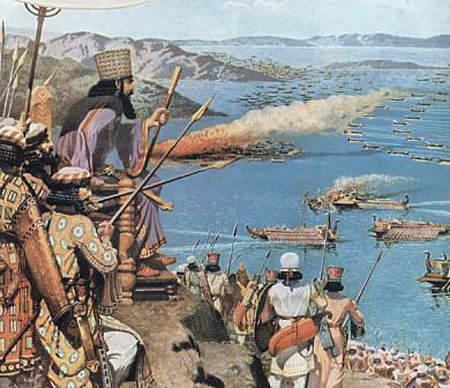
Introduction
Salamis (its Greek name) certainly the largest and most decisive naval battles of all times, and is often cited as the most preeminent naval battle of the antiquity. It is often associated in that regard to the sea peoples battles of the bronze age, Actium, Lepanto, Trafalgar, and closer to us, Jutland and Midway. Due to the time it happened and records of that time lost, we are not sure of the date, only of a general consensus allows to consider September as the month it happened.
What is certain however, it was massive in scale, just and like at Lepanto which is often compared, pitted against each others entire coalitions of nations and empires. On one side, Several Greek league city-states led by Athens, and on the other, the mighty Persian Empire, made of several nation’s fleets. At stakes, the future of Greece, its independence towards the Persian Empire, then on the rise, capitalizing on tired city-states rivalling against each others. After its defeat, Persia would only play the arbiter between Greek leagues during the Peloponnesian war which started in 430 BC. It was a decisive victory, showing the skills of the Greeks in their home waters, as well as some chance. It became a symbol for Athens, it immense pride, fuelling the prestige of its navy for the centuries to come, an heritage carried out by modern Greece.
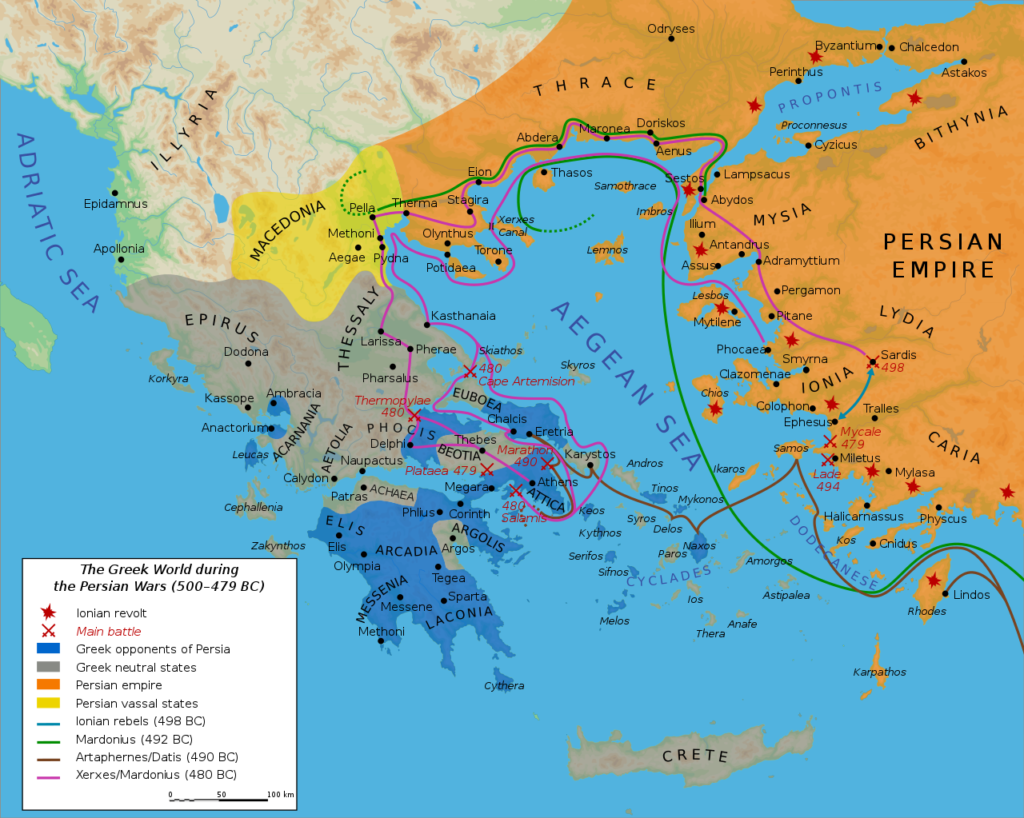
Map of the Mediterranean around 480 BC – Greco Persian wars
Context of the battle
The Greek-Persian wars was the result of several factors:
-The recent and seemingly rise of the Persian Empire, greeted by particularly competent kings since the origins
-The ambiguous position of some city-states and diplomatic skills of the Persians
-The tolerance policy of the Persians, seductive for those not willing to commit to war
-The uneasy alliances of city states and rivalry between leagues
The Ionian revolt
Bronze age Greek settlers
The background of this conflict could be found in the the collapse of the Mycenaean civilization, many Greeks fleeing eastwards, emigrating in Asia Minor, settling on the western coast. Soon, with links with the Aegean islands that made coasting with small cargo ships easier, and links to their homeland, they flourished through trade, connected to the eastern trade networks. This “Ionian invasion” is not however similar to the later colonization of the Mediterranean, with colonies and Emporions as far as Spain, North Africa or the Black sea. Among the settlers of this first migration were also Dorians and Aeolians. They urbanized Lydia and Caria, founding twelve city-states in Ionia, soon famous, but also Miletus, Myus and Priene in Caria and Ephesus, Colophon, Lebedos, Teos, Clazomenae, Phocaea and Erythrae in Lydia, plus later the islands of Samos and Chios. They soon crated a sacred place for yearly meetings, games and religious festivals at the Panionion. In all but form, they would create a ‘cultural league’, but this was still not a political entity, such as later greek leagues led by a strategos.
Athenian support of the Ionian city-states
Another point behind the war, was the relations between the new Empires and the city-states of Greece. In 507 BC, Artaphernes, brother of Darius I, was the Satrap of Asia Minor, ruled from Sardis. He received an embassy from Athens, under Cleisthenes, which just established its democracy and searched fir some support against Sparta. Artaphernes which did know about the Athenian alledged asked them for a symbolic offer of “Water and Earth”, Persian symbol of submission, for help, which Athenians probably baffled ambassadors accepted. However Artaphernes advised them to receive the back the tyrant Hippias they just threw out. The Athenians refused the ambassadors proposal and disavowed them back home. Under this promissed submission and rejection of the ambassadors, and later forceful intervention in the Ionian revolt, the Achaemenid King decided it was time for retaliation. This was the start of the war, taking place on the coast during the Ionian revolt.
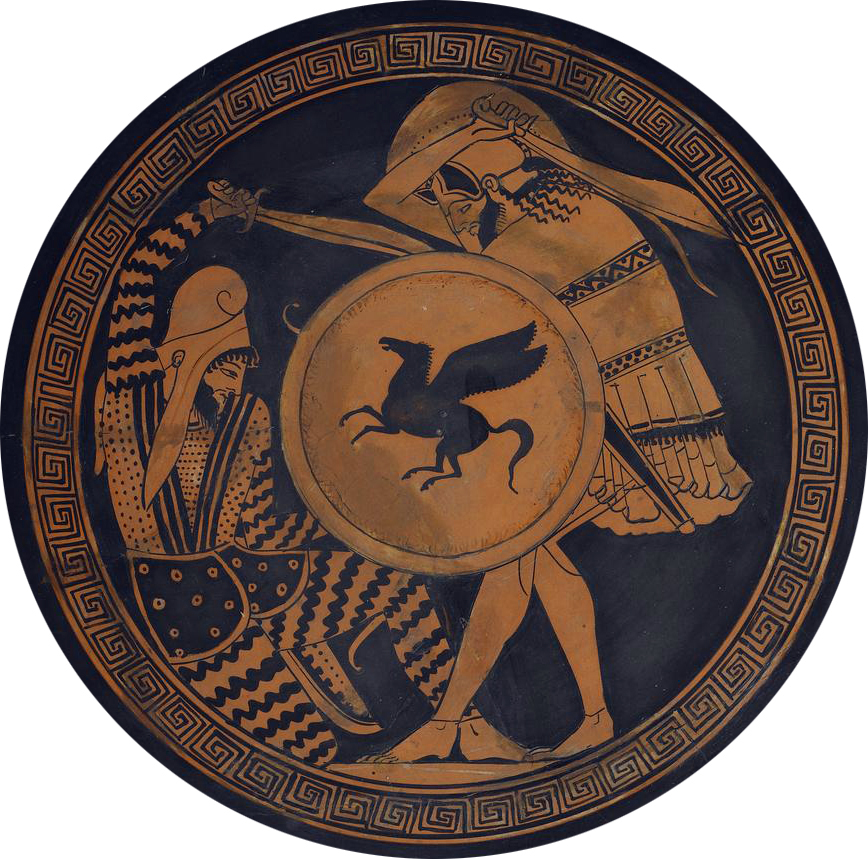
Lydian rule: Croesus campaign and fall
They remained independent until conquered by the Lydians. They themselves were at war with the Median Empire later, but reached a settlement. From 560 BC however, the famous Lydian king Croesus set about conquering the other Greek city states of Asia Minor. A few years after, a Persian prince, Cyrus led a rebellion against the Median King and won. The Persian Empire was born, and soon, led by bright and ambitious rulers, quickly became the greatest Empire known to man to that point. The border between Lydia and Persia, the river Halys, held, but perhaps because a misinterpretation of the oracle of Delphi, the Lydian King believed he would crush the Persian Empire with ease.
At the contrary, he was soundly defeated and his Empire was added to Persia. The latter had problems with the independent-minded Ionians. Cyrus tried to work with local aristocrats but they were squabbling between each other and had limited powers due to the more democratic regimes of these city-states. They found a way by sponsoring local would-be Tyrants (the title does not reflect their ancient nature, far less autocratic), which power was backed by Persian garrisons. This situation only made matters worse, and the Ionians rose in rebellion.
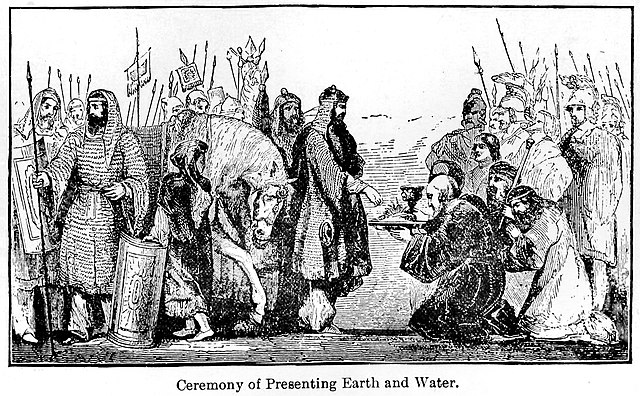
508 BC, Athenian ambassadors are presented a symbolic demand for earth and water by the Persians
The Ionian revolt starts
The first part of the war was the armies raised by Aeolis, Doris, Cyprus, and Caria under a military strategos to led a general revolt covering most of western Asia Minor, against Persian rule. It would last from 499 to 493 BC. This went beyond, as several tyrants were expelled, killed, or joined the rebellion, led by Milesian tyrants Histiaeus and Aristagoras. The latter gathered his armies and marched on Artaphernes, and started by conquering Naxos. This was a debacle and he instead tried to ignite a revolt in the whole of Ionia. One year into the war, in 498 BC, he received reinforcements from Athens and Eretria, and the Ionian army gathered and marched on Sardis, which was taken, plundered and burnt. This was quite a blow for Persia, which soon arrived, catch the Ionians on their way back and crushed them at the Battle of Ephesus. After this initial success in 497 BC, a new, massive Persian army arrived, headed by Darius, then separated in three, each targeting areas of rebel territories. However soon Caria joined the fight, and the largest, led by Darius rushed in Caria. However after initial success, he was ambushed at the Battle of Pedasus. The situation stalemated in 496-495 BC, with sweeps and skirmishes on both sides.
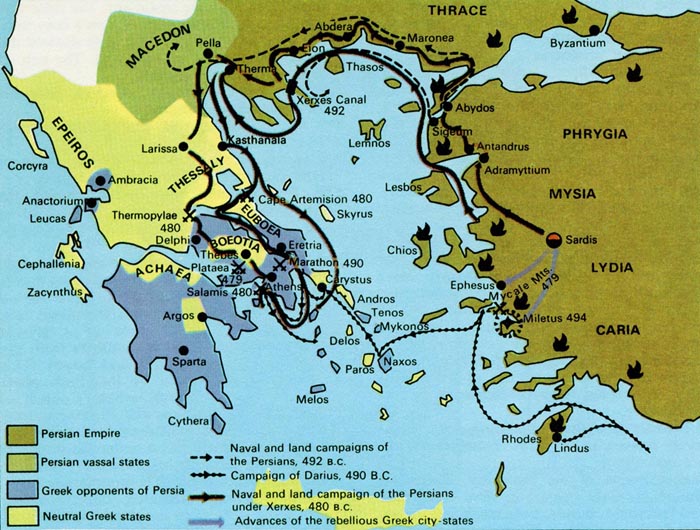
Another map showing Persian moves and battles of the war SRC
Persian all-out total war
By 494 BC the Persian forced came with a revenge, both a new, massive army assisted from the coast by an equally impressive navy. Regrouped, they headed straight for the epicenter of the rebellion at Miletus. The small Ionian fleet (in comparison) at first was deployed to defend Miletus by sea but it was crushed at the Battle of Lade. At the last moment, the Samians fleet defected (Persian gold ?). Miletus was besieged by sea and land and eventually captured: Its population was enslaved. This crippling blow as this was the Ionian revolt capital, ended the rebellion. The Carians surrendered soon afterwards. In 493 BC the Persians subdued the remainder of rebellious cities, installing garrisons and their own men in command as tyrants. The Greek west coast was now definitively under Persian rule. A peace settlement for the whole of Ionia, which largely depended on trade from these cities, was agreed for, estimated by Herodotus under “just and fair conditions”. The Ionian Revolt was however only the first phase of the Greco-Persian Wars.
Darius was now free to turn to the greatest support of Ionian cities, Athens, and Eretria in a second phase. At that time, the political situation in Greece was tense and city-states were divided. Darius estimated the time was ripe for conquest.
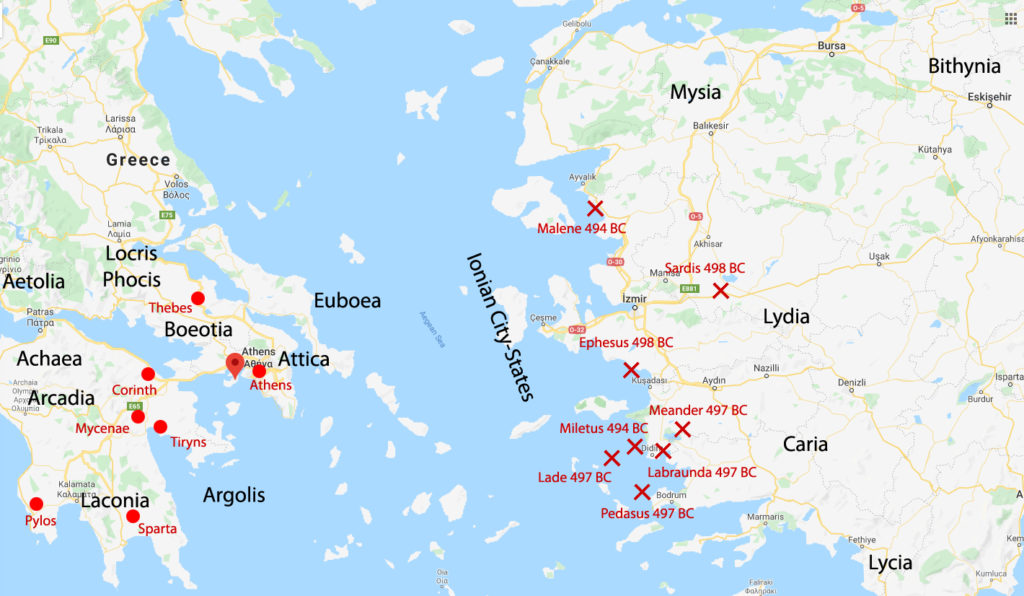
Naval Encyclopedia own map summarizing the Greco-Persian wars
The Battle of Lade, 494 BC
This was the epic naval battle that pretty much decided for the fate of the Ionian cities.
This crushing Persian naval victory eliminated all hopes for the Ionians to protect their coast against Persian rampage and blocus, onlt the Athenian Navy could help (which it failed to do, embroiled in local disputes). Miletus was the theater of this titanic clash, on the southern side of a very large bay, at mouth of the Maeander River. Lade was an island off the coast, west of the city-state. Lade and Miletus were inland with a river running north of them.
Ionian leaders met at the Panionium, the sacred local sanctuary, located on the northern side of Mount Mycale, opposite side of the Maeander estuary. It was by then decided to create the largest navy under a single command, built and financed by all Ionian city-states and that the defeat of the Persian fleet was the condition to defend Miletus by land (as soon as the city could be supplied). In total, the Ionian funded the launch of 353 ships. Individual contingents depended of each one of them. The Milesians made the eastern wing of the battlefleet with 80 ships, a fourth of it, and Next was the Prienean fleet, only 12 ships, followed by Myous (3), Teos (18), Chios (100), Erythrae (8), Phocaea (3). Non-ionian cities provided an additional 70 ships from Lesbos (Aeolia) and the Samians at the western side (60 ships).
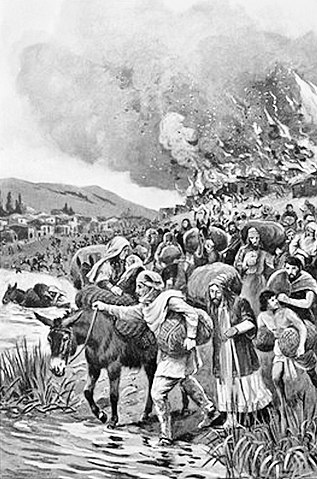
The burning of Sardis
Despite of this armada, the Ionians were outnumbered by the Persian fleet, estimated by ancient authors to be around 600 vessels, nearly twice as much. The bul was constituted from smal and relativly light Egyptian vessels while the most numerous and best were from Phoenicia. In addition, tyrants expelled from the Ionian cities returned wit their own small private fleets. At Miletus a stand-off battle started, with no clear victory in sight, lowering the morale of the Ionian fleet. Herodotus reported that Dionysius, the experienced commander of the Phocaean was given command of the fleet and ordered training, which was refused by the Ionian fleets, which refused to cooperate at any level after a week of intense exercizes, probably due to the small weight of the Phocanean fleet compared to the others.
Herodotus also reported an efficient Persian moral campaign, with messaged delivered by former tyrants to their relative cities, with the threat of enslavement and destruction if they decided to go on on this revolt. Only the Samians at first fell to this, believing the war couldn’t be won, provoked by the collapse of discipline in the Ionian fleet army and navy. The Persian fleet departed to attack the Ionians, which formed up into a single column. Herodotus provides no clues as what fleet was best among the Ionians, but the Persians had a decisive advantage as soon as
the Samians left the fleet and sailed away, only 11 ships staying behind to defend the cause. Still, with 50+ less warships, the situation was made even more difficult, compounded by the low morale. Following the defeat, Samos was spared by the Persians. But as they departed, the whole Lesbian contingent went with them.
Heorodotus also reported the rest of the Ionian fleet fought on with vigor, notably the Chian fleet, even inflicting heavy losses on the Persian fleet. Eventually they were all surrounded and overwhelmed by marines troops. A few surviving Chian warships fled towards the north across the bay, and ended on the beach of the southern shores of Mount Mycale. They soon departed for the Ephesian territory, but were ambushed there by the latter because of a long rivalry between Chios and Ephesus, or possible misidentification, but that’s dubious. For the Persian fleet it was not a promenade either but they simply overran the Ionian fleet, which allowed later to besiege Miletus by sea.
Second phase of the war (492-490 BC): Persian invasions
Mardonius campaign
492 BC Mardonius’ campaign: Darius’s son-in-law Mardonius took back Thrace (a part of the Persian empire since 513 BC). This backward area was divided between quarelling tribes, it was easy to pay some as mercenaries against others. Mardonius’s army then arrived at the gates of Macedon, and persuaded the king to become his client, formerly a vassal with more autonomy. Mardonius’s fleet however was destroyed by a storm off the coast of Mount Athos. Later his camp was raided by a Thracian tribe, forcing the remnant of his forces to sail back to Persia. Darius in 493 BC sent ambassadors to all Greek city-states, asking each time the same submission gifts. Only Athens and Sparta refused. Both instead executed the ambassadors, further infuriating Darius and took a year and a half preparing a military campaign, sending his trusted generals Datis and Artaphernes in 490 BC.
Datis & Artaphernes campaign
Both generals led a powerful amphibious invasion force from Cilicia, stopping first at Rhodes, besieging Lindos without success, then departing to Naxos. They easily overwhelmed the latter, and enslaved those which did not fled to the mountains, and burnt the city to the ground. The fleet then crossed the Aegean, stopping in many islands and ending in Eretria, taking hostages and troops along the way. The Eretrians were besieged but held for 6 days, but eventually the gates were opened by betrayal. The city was razed, temples looted and burned, population enslaved.
Battle of Marathon
Ten years before Salamis, this was the climactic battle of this war: The Persian fleet went along the coast of Attica and landed at Marathon, a bay roughly 40 kilometres from Athens. There, under General Miltiades, an Athenian veteran of previous battles with the Persians, an hoplitic army went there, camped and Stalemate for five days, before the Persians decided to re-embark their troops and sail directly to Athens. It was when they had loaded their cavalry that the Greek attacked. Some 10,000 Athenian charged down the hills and around the plain, crushed the weaker Persian foot soldiers, routing the wings and surrounding the center. What was left of the army fled one their ships, leaving 6,400 dead behind, for 192 on the Athenian side. As soon as it was over Miltiades sent a runner to Athens (the famous story which “invented” the Marathon) to warn the city to prepare for a siege and that reinforcements were coming.
Fortunately the Greeks, on forced march, arrived in time to to stop Artaphernes as he was to land and the latter had no other choice but to sail back to Persia. The Battle not only was a formidable boost for morale throughout Greece, and proved the superiority of hoplitic infantry over the Persian infantry.
Interbellum (490-481 BC)
After both his campaigns had failed, Darius started immediately to raise a much more massive, brand new army to subjugate Greece once and for all. He recruited troops in masses from all over the empire, promising glory, loot and slaves. In 486 BC however Egypt rebelled. The expedition was postponed, after three years of gathering troops. Darius preparing his army to fell on Egypt when he died. The throne passed to his son Xerxes I, which first action was to led his father’s army to crush the Egyptian revolt. Immediately after, when back home, her prepared for the invasion of Greece, a full-scale invasion with long-term planning. He started to stockpile ammunitions, food and water, clothing and herds to follow the army, and started a massive conscription, plus recalling satraps to send troops from all over the empire. He decided to cross Hellespont on a massive pontoon bridge, allowing cavalry, chariots, and elephants to cross. He also decided to dig a canal across the isthmus of Mount Athos. Those exceptional endeavour alone set the tone and showed the power of his Empire. However the expedition was delayed again to quell yet another revolt in Egypt and another in Babylonia. There were aces cards in Xerxes hands: His army was humongous, even by the time’s standards, and he had the sympathy of several city states, such as Argos, pledging to defect and Larissa in Thessaly which saw this as an opportunity to settle scores, while Thebes was ambiguous.
Xerxes Campaign (481-480 BC), prelude to Salamis
At last, the expedition was launched in 481 BC, after Herodotus 46 nations send troops, for which he takes the time of describing their appearance and armament. In the autumn the armies were gathered in Kritala in Cappadocia, joined by Xerxes to Sardis, staying there for the the winter. In spring Xerxes army moved to Abydos, to be joined by western satrapies own armies. He then crossed the Hellespont without resistance. Modern historians agreed the army was around 200,000 while ancient authors went as far as pretending they were million strong. It was assisted by a composite Persian fleet around 1207 ships strong (Herodotus), but modern historians rather sees something like 600 ships, like in Salamis.
Athens adopts Themistocles naval policy
The prime target of this seemingly unstoppable force was Athens. A year after Marathon Miltiades was incapacitated and and the Alcmaeonid family prosecuted him for the failed campaign at Paros. Instead, Themistocles, a politician with a network of partisans and large power base became the people’s champion and took back Miltiades’s shoes after he died. Quite an influential politician he strongly milited for the expansion of the Athenian naval power, in the light of the threat from Persia. His rival Aristides, was the champion of the zeugites (upper hoplitic society), trying to oppose him. By 483 BC, the sliver mines at Laurium were opened, sending rivers of cash to the city state. Themistocles proposed to built a fleet of triremes, notably in the context of a war with Aegina.
Ancient sources are unclear over how many were built, 100 or 200, perhaps as some suggests, in two separate votes. Aristides’s opposition to Themistocles led to the ostracism of 482 BC, for Aristides. Themistocles now had free hands to implement his naval policies, in the knowledge of Persian preparations. The Athenians voted for more ships than Themistocles first asked, reaching perhaps 300 ships. They were not all triremes however (see later). Meanwhile in Sparta, King Demaratus was replaced in 491 BC by his cousin Leotychides and went into exile, humiliated. He made his way to Darius’s court in Susa, and from then became his military advisor, later became Xerxes’s one for affairs. He was close to him all along the second Persian invasion.
The Greek alliance
Prior to the invasion, Xerxes sent ambassadors asking for tokens of their submission and avoided Athens and Sparta, after their previous refusal. Nevertheless, context had changed since Marathon and many city states chose to ally themselves with Athens and Sparta. A congress met at Corinth by late autumn of 481 BC. It was decided to create a confederate alliance which had powers to send envoys and oversee troops sent from the member states, after consultation. These Allies were led by Sparta and Athens to accept a defensive strategy as the best of interests. But this primitive “league” only counted one on then city states, 70 out of 700 city-states, still a remarkable success for a time of rivalry and unrelenting warfare since 200 years. This setup a precedent which will be confirmed in the Peloponnesian wars, but this time with Athens and Sparta as rivals and Persia as an arbiter.
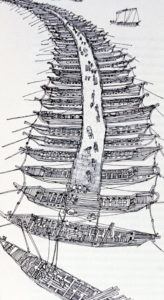
480 BC: The land campaign
The second invasion of Greece could be separated in two stages: First, the northern campaign, in Thrace, Macedonia and Thessaly, and then the souther campaign and the battle of Themopylae and Artemisium. The third strong point of this year is of course, the naval battle of Salamis.
The northern campaign
After its crossing of the Hellespont, Xerxes planned a march to the Greek peninsula by land, 3 months being necessary to travel to Therme. The army stopped at Doriskos joined by the fleet and extra supplies, and Xerxes reorganized troops into more manageable, smaller tactical units composed of troops from every armies given their respective use, strength and weaknesses. Before that, Satrap’s national armies were just followed each others in columns and their own baggage train. They were all easy preys for ambushes, especially in mountainous terrain. The cavalry was assembled also in mixed units, using lighter ones to scout the regions crossed, sometimes days in advance.
Meanwhile the Allies met in the spring of 480 BC, and decided to defend the Vale of Tempe, bordering Thessaly to block Xerxes. This was a sound decision as this was a narrow point, and in Thessaly, the plains would have been a gift to the Persian’s immense superiority in cavalry. Alexander I of Macedon, albeit a client state of Persia, but Greek at heart, warned them however that the vale could be bypassed, allowing the Greeks to retreat. After it was reported the Hellespont was crossed, the allies devised another strategy. Themistocles suggested that to reach southern Greece, the peninsula’s regions of Boeotia, Attica and the Peloponnesus needed to cross the narrow pass of Thermopylae which can be easily be blocked by few Greek hoplites, negating Persian’s superiority in numbers. To prevent them bypassing Thermopylae by sea they also decided to block the straits of Artemisium with the fleet. There was however a back-up plan to defend the Isthmus of Corinth and to evacuate the Athenians to Troezen in the Peloponnesus.
The southern campaign
Xerxes’s troops arrived at the Thermopylae (the “hot gates”, after volcanic springs nearby), just as the Olympic Games and the festival of Carneia started. The Spartans were the closest to intervene, but warfare was subjected to religion and while they observed the festivities, as a compromise, they sent king Leonidas I with his personal bodyguard called the Hippeis, 300 men strong. At the time, since lycurgus’s reforms, Sparta had two kings, one charged of internal affairs, to other war and diplomacy. Leonidas’s 300 elite hopltes were however supported by Allied from other Peloponnesian city states and more on the way. The pass was occupied, the old Phocian wall rebuilt at the narrowest point, and the troops settled and waited.
The battle of Thermopylae happened in mid-August and at first, the Persian waited for three days, hoping the Allies would disperse. He then launched the attack. However for two days on end, this place was ideally suited for defensive, hoplitic warfare. Persian losses were tremendous despite launching waves after waves of troops, before Xerxes decided to send his Immortals. An elite corps named after the reserves it had, to produce a contingent always 10,000 strong.
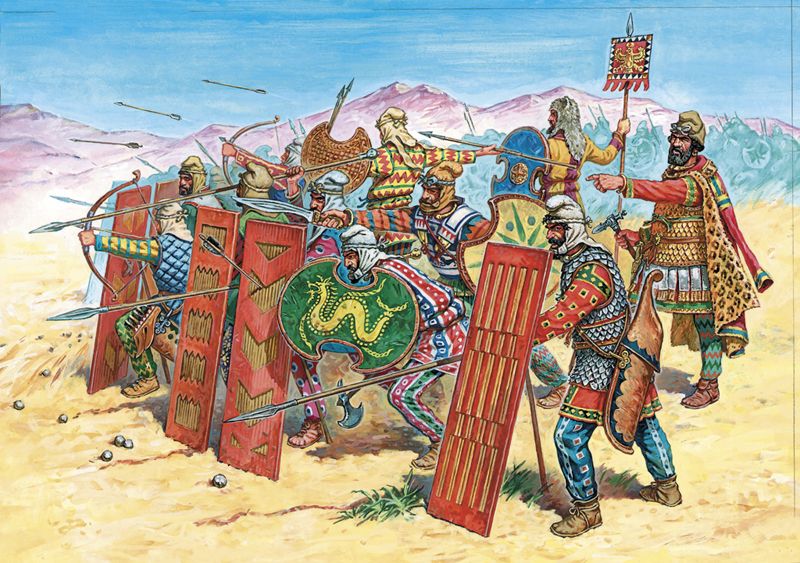
Typical appearance of Persian troops of the time (Hat models)
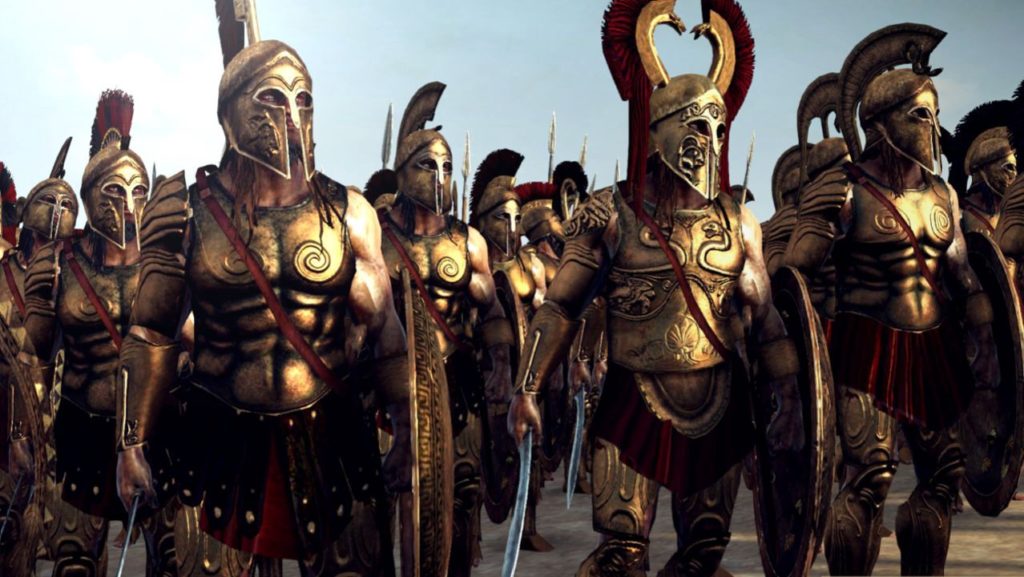
Spartan Hoplites at the time of 480 BC
According to herodotus, our sole source on this, a local resident called Ephialtes revealed a narrow goats mountain trail leading behind the Allies. Wether it is true or an embelishment, what was called the Anopoea path was defended by about 1000 Phocians which fought and fled. Once it was known to Leonidas, he dismissed the Allies and decided to stay with those among allies who wanted to, around 2,000 men in all. A legend was created, perhaps the ultimate last stand in history, but it was certainly not “300 against a million” as often fabled.
As this event took place, the an Allied naval force, 271 triremes and smaller ships, arrived at the Straits of Artemisium to block the Persians, and protecting the flank of Thermopylae’s Greeks. The fleet rebuffed the Persians for three days but after news Leonidas and the pass were lost, and after its losses, the allied fleet withdrew to Salamis. From then on, the final chapter, the waterloo of this campaign, is about to take place. But before that, let’s have a look on this prelude, the battle of Artemisium (see later).
Ancient Sources
Sources: For this era, almost all rested on Herodotus works. The “Father of History” was born in 484 BC in Halicarnassus, by then in the Persian Empire. So he knew both cultures (Greek and Persians) and the motivations and peculiarities of the conflict he knew during his youth. The conflict ended in 449 and he wrote about it around 440 and up to 430 BC so supposedly fresh material. He is trusted on this because of its proximity to the sources, however he was not a traveller contrary to Thucydides or later Polybius, and only reported what he has heard, leading to some fabled-like accounts for distant countries. Thucydides in particular started over the siege of Sestor, where Herodotus left, and criticized his methods but found him accurate enough not to need re-writing or correcting. What happened after Salamis, between the end of the second Persian invasion of Greece and the Peloponnesian War in 479–431 BC, is however rather obscure due to the lack of known sources.
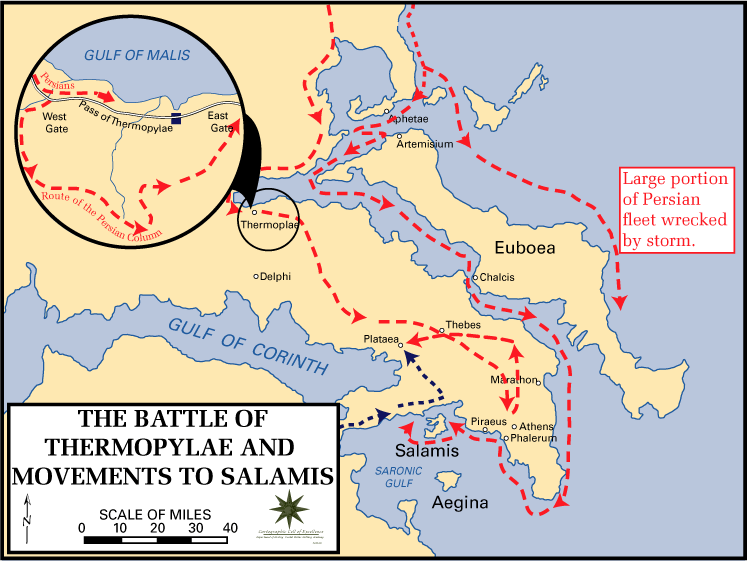
The greek side: A point on trieres
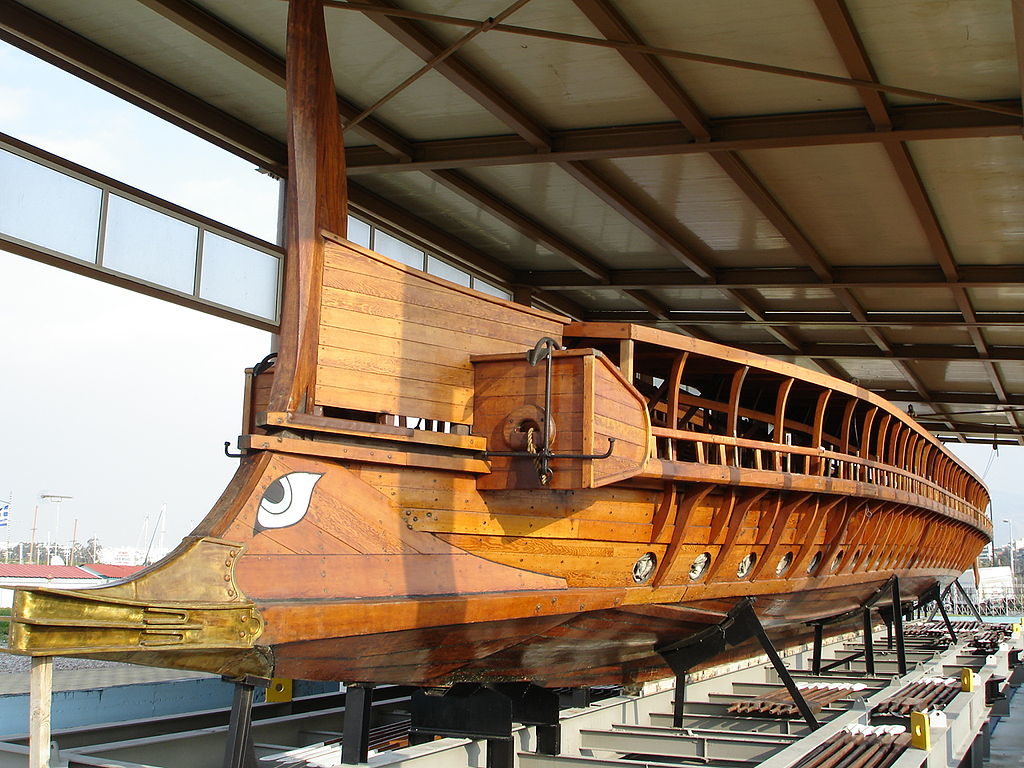
Before going into the meet of the battle, let’s see opposing forces, before Artemisium. As stated earlier, the Allied fleet, of which the bulk was Athenian, counted 271 triremes, or to be more precise “trieres”, the greek name. “Trireme” (“tri-remus”) was Roman. When things became touchy for the Romans in the first Carthaginian war (so 200 years later), they quickly built a fleet of triremes, meaning three men in a row, each with his own oar. But as they later adopted their own tactics, they swapped over a heavier type, already used by Hellenistic powers, called the quadrireme and quinquereme. These were heavier with 4-5 men respectively “per row”, meaning two men per oar at the higher level (typically 2+2+1 for the quinquereme). But this was still a “trireme” in appareance. In fact no ancient source, bas-relief or painting, never ever shows more than three rows on a military ship of the time.
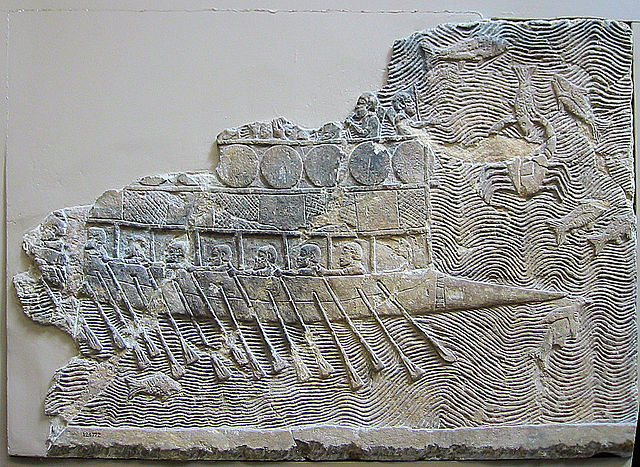
Assyrian Bireme
The famous, mighty trireme seemed to have been equal to the invention of the broadside ironclad, the submarine, the dreadnought or the aircraft carrier, a game changer. But was it ? The idea of stacking rowers onto a slender, lightly-built ship, which is a proper military vessel, is related to naval warfare as it was practised since the late bronze age. This was when the first “two-stage galleys” first appeared, apparently invented by the Assyrians or Phoenicians in the east.
The triere has many fathers and we will probably never knew for sure. Bas reliefs after 3500 years had become hardly readable and records are scarce. One contender for invention, a serious one, was the Phoenicians. They created the first true modern, sturdy construction technique by using the classic keel and frame method, obtaining a ship that was able to sail in open sea and cope with heavy weather. At that time, Egyptian boats were so flexible that instead of a keel they had a ropes-based reinforcement called an “aerial keel”, and small parts sewn together. They were great for the nile but in open seas and heavy weather because of tensions on the main ropes they were prone to break and literally “spread” at sea. The Phoenicians also invented the first dedicated cargo ship, later copied by the Greeks, later their trade rivals in the Mediterranean. They also pioneered the military galley and its therefore not excluded they effectively created the first triere. Basically, three oars per section, each at a different level. On a diere, rowers sat just at different places, and is it possible the concept was just pushed further using the same system. Some authors traced back the triere to Sidon, Thucydides to the Corinthian naval architect Ameinocles.
But it’s really the Athenians which are credited as the progenitor of the Triere in its modern form, at least the one which was seen in action in 480 BC. To make it narrower, thus faster, the only way was to have the oarsmen sat in three much more pronounced stages, the lower one sitting more than the height of a man below the upper rank. They were called the Zygites, Thranites and Thalamites regarding their place, the latter being the lowest ones, just above the waterline. They were also the weakest and poorest of the lot, having to pull shorter oars, but lacking air being deep down. The best placed were not at the top but the middle. At least they were protected by the heat of the sun and water splashes while having more air, and the last were much more exposed, including from arrows and javelins in close melee. The upper oars were not that longer thanks to a 800 BC invention of parexeiresia (outriggers), allowing the lever point to be further out.
Just like the Egyptians, the trieres were so light they needed stiffening by using bracing, what was called the hypozomata. This undergirding was made of large rope cables 4.7 cm in diameter and each ship carried two spares. The design of the ships and disposition of rowers was so well and precisely crafted and balanced that changing any parameter would have compromise the ship ability to work correctly. The triere was, in short, a miracle of ancient engineering, the most technically advanced moving object ever made up to that point. The rule of the triere, which really started at that time, imposed itself until the Romans dominated the Mediterranean, and themselves still used them long afterwards, despite using different tactics.
What made the Greek triere such an ideal war machine compared to older galleys was a combination of factors:
-By keeping the ship narrow and light, it was faster by design
-The concentration or rowers was such that raw power compensating for the added weight of the hull
-The triere was not “aphraktoi” like previous ships but “hemi-aphraktoi” or semi-covered: There was a platform built over the rowers with a central trench to access the lower deck. This also protected the rowers from heat and sunburns, but the sides were still open, making the structure lighter. “kataphraktoi” ships appeared with the Hellenistic era around 300 BC. Their decks were enclosed completely, but they were no longer trieres but tetreres and penteres (‘4’ and ‘5’).
-The roomy deck allowed more troops to be carried, an advantage for melee combat.
-The heavy bronze ram, with a socket shape reminiscent of a spearpoint, strapped on the ends of the keel and largest timbers along the hull, made it stronger.
-The large square sail and small forward sail used for manoeuvring in harbour and close spaces.
-The hull was deep enough to be enclosed at its base, used for storage (notably water) and ballast.
-Made of light wood, the triere could be carried ashore by as few as 140 men

Olympias, from the reconstitution of a typical early Athenian triere of 480 BC. Very light (to the point it was common they broke in two when rammed), lots of air passing through the raised platform, few troops. They were the first to receive apparently bronze rams, earlier ships had wooden ones, bordering to the decorative.
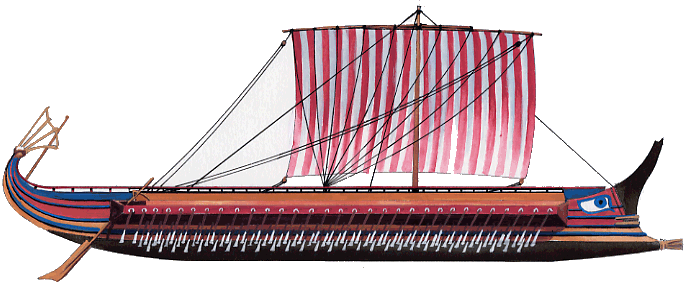
Hellenistic-era triere, just here to show the difference with earlier vessels, 100 years prior. Innovations: Heavier, more solidly built, fully enclosed deck (but the central trench), and belt armour (against ramming) – The Romans went further and created iron belt armor worthy of a battleship. They dropped agility for protection and firepower.
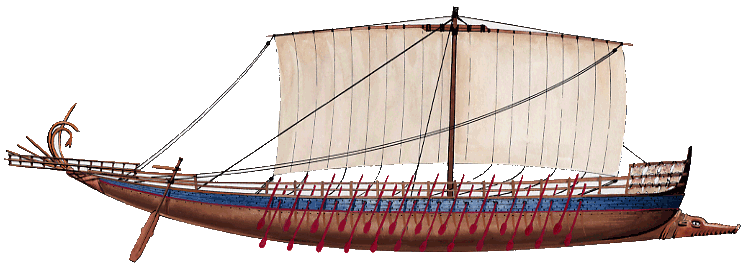
A greek diere of the 7th-6th century BC. They were the main warships before the triere appeared and generalized in the 5th century.
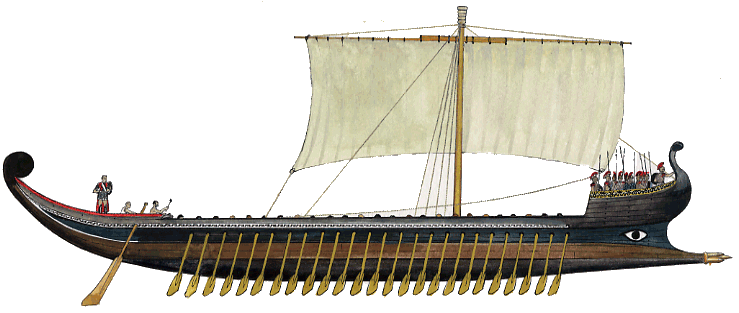
Pentakonteros: With 25 rowers either side and a light and slender hull they were quite fast but carry few troops and were unstable. In 700 BC they were quite common, the first apparead during the bronze age. Thes were “aphraktoi”, open bridge vessels, with small platforms at the end of the rowing section. They were still around in many fleets due to their limited cost and crew in the 5th BC.
![]()
Greek Trikonteros – Its is unclear if this ship had 60 rowers or 30. The term of “cisoconter” is also found for these primitive, bronze age galleys, still used by minor fleets and used as supply scouts and dispatch vessels.
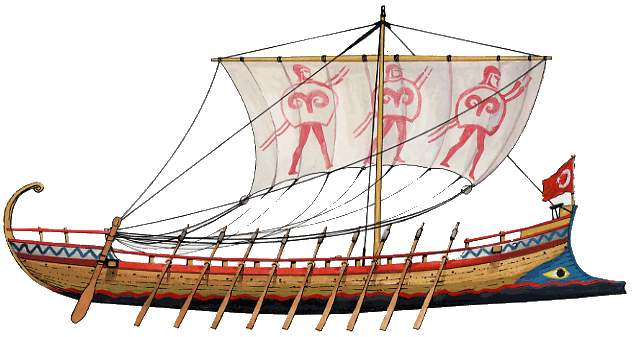
‘Monerei’, the generic term for small ships with a single row line (below a diere). The Argo is not strictly speaking a ‘diconteros’ as she had one less rower per side (18). Classifications were made in the classical age when city-states tried to manage their fleets.
Thucydides clearly stated that when the Persian Wars started, the Greek navies consisted of penteconters* and ploia makrá (“long ships”). The battle of Lade, which saw the Persian and Ionian fleet fight, probably were made primarily of dieres and smaller ships. Its only when Athens started its arms race with the rest of Greece under the patronage of Themistocles, that the triere became the dreadnought of her day. Every fleet wanted some. Trieres were costly in maintenance, and needed a dry storage everyday, if possible in a dedicated shed, which became the norm.
The typical triere crew (plērōma) comprised 200 men, for 37 m in lenght, 4 m in width (so a ratio of nearly 1/10). The captain was a wealthy Athenian called the trierarch, often coming from the pentakosiomedimoi. This was a prestigious position to be in, but came as a financial burden as well, whereas the ship was financed and built by the state.
He was assisted by the kybernētēs or helmsman, an experienced seaman, the prōreus or bow lookout, the boatswain (keleustēs), quartermaster (pentēkontarchos), shipwright/carpenter (naupēgos), about ten sailors manning the sails, and the piper (aulētēs) giving rhythm to the rowers and two superintendents (toicharchoi) which fed and watered the rowers. The latter were men aged probably in their thirties, and paid for the job. They were not slaves at any level. They were skilled, trained professionals and acted as mercenaries, coming with their own oar and cushion. In Athens, the fleet was so important they formed a class of themselves, called the thētai. These citizens were not the only recruitment source: Metoikoi (Metics) were accepted as well, as hired foreigners. In any case, the triere rower force comprised two levels of 62, 54 and 54 rowers respectively for a total of 170.
With 200 trieres, these were 34,000 men, not counting crews and troops. In any case, these rowers were taken great care of, and men in their late forties and even fifties still in near-athletic conditions were accepted and well rewarded. These veteran rowers were often placed at the top, the most difficult position. They often gave regularity and imposed stamina for the other ranks, just because their oars “framed” lower ranks ones. They were compelled to follow the rythm. They were not supposed to fight however, but their stamina was needed to avoid being rammed, and so their performed accordingly for their own safety. A bronze bow weighting a ton could penetrate deep inside any hull and do some gruesome damage along the way.
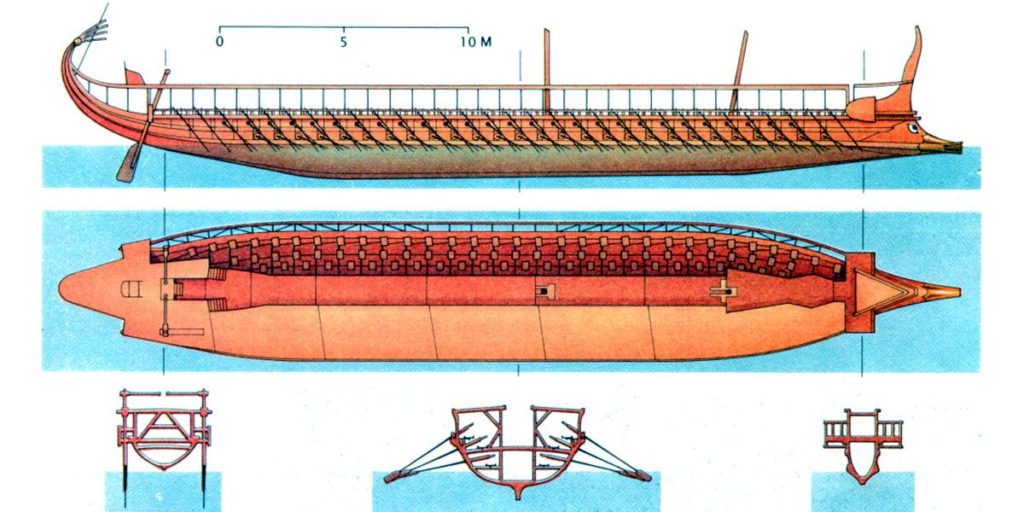
Cutaway of a triere such as the Olympias (Osprey)
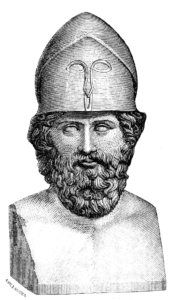 When themistocles ordered a fleet of triremes, Athens was embroiled in a conflict with Aegina, which at that time had quite a formidable navy. Woth the knowledge of Persian preparations for an invasion, in about 483 and 482 BC the assembly was persuaded to vote for the construction of 200 triremes and their baptism of fire was at the Battle of Artemisium. There, both sides suffered great casualties, and due to superior numbers, the greeks had to flee to fight another day. The decisive clash happened at Salamis, destroying Xerxes’ invasion fleet and preventing support and further advance of his armies. The Athenian trieres were just getting started as an instrument of power in the eastern Mediterranean: Next, they fought brilantly at Mycale, this time on the Ionian coast, defeating any attempt by the Persians to blockade coast. This essentially, helped to free the Ionian cities.
When themistocles ordered a fleet of triremes, Athens was embroiled in a conflict with Aegina, which at that time had quite a formidable navy. Woth the knowledge of Persian preparations for an invasion, in about 483 and 482 BC the assembly was persuaded to vote for the construction of 200 triremes and their baptism of fire was at the Battle of Artemisium. There, both sides suffered great casualties, and due to superior numbers, the greeks had to flee to fight another day. The decisive clash happened at Salamis, destroying Xerxes’ invasion fleet and preventing support and further advance of his armies. The Athenian trieres were just getting started as an instrument of power in the eastern Mediterranean: Next, they fought brilantly at Mycale, this time on the Ionian coast, defeating any attempt by the Persians to blockade coast. This essentially, helped to free the Ionian cities.
This, in fact, conducted Athens to form Delian League, the first of the Greek leagues, illustrating a new word: Hegemon.
The predominance of Athens became an Empire in all but name. This fleet of triremes (more has been built after the second Persian invasion, still thanks to the Laurion abundant silver production. Athens as a thalassocracy, the first of the kind, was born. It had a strong fleet always composed of more than 200 triremes, not counting smaller ships.
After controlling the Aegean Sea, they started a campaign against piracy in the whole area, securing trade routes and notably grain shipments from the Black Sea. This was Athens’ golden age, and as Themistocles said “he who controls the sea, controls everything”. This famous maxim was taken at heart in the XIXth by a new Thallassocracy and Empire: The British Empire. Instead of triremes, it had steam-powered ironclad and later dreadnoughts, enough to take on the two world’s best navies together; The nationalistic figurehead “Britannia” was basically the Goddess Athena, with a corinthian helmet and trident, representing sea power, and the British Lion nearby, representing the Empire. It’s not at random neoclassical architecture and style was back at the same time national identities were formed and new countries entered the Fray, such as Italy and Germany.
In addition to its political benefits, and prestige, the fleet provided permanent employment for the poorest citizens and promoted the Athenian democracy at a time many city-states were ruled by Tyrants, oligarchs or Kings. The Athenian maritime domination however was challenged by other city-states, notably Syracuse, Corfu and Corinth. Sparta had a small navy and did not invested much in it, before the Persians funded it to ensure victory over Athens during the Peloponnesian wars. Athens fall started in the ill-fated Sicilian Expedition, and ended decisively at the Battle of Aegospotami, but this is another story…
Origin and older vessels:
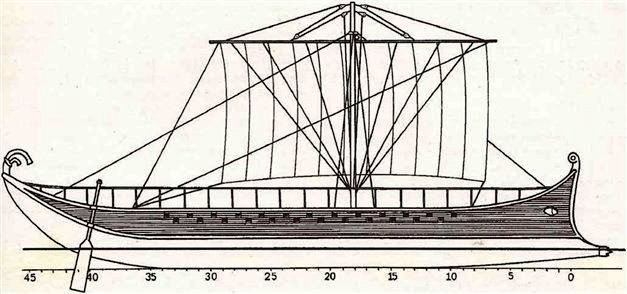
Ivlia, Ukrainian/Bulgarian reconstitution of an ancient Greek black sea diere (bireme)
To the west, the paternity of the diere came to Corinth, invented by possibly the Boeotian Greeks following the Trojan War or the Erythraeans of Asia Minor, 8th century B.C. This consisted in making the ship larger and wide to accomodate more rowers, up to 120 in four separate rows, two of 30 either side, seated on benches placed at various height, alternating. This way, they took less space and the ships stayed relatively small. This bring two advantages: The speed and weight authorized ramming for the first time, enabling a whole range of tactics, and the oarsmen could take arms if needed to defend the ship, added to the crew, in case of a pirate attack, which were common at the time and in the aegean sea. The most common vessel of this type was had 100 oars and was therefore called an “ekatontoros” with a lenght of 32m and 4,80 m in width. It was less narrow than previous ships, notably the infamous Pentekonteros, and this could carry more troops.
This was already a “massive” ship for the time and a completely different concept than the Assyrians and Phoenicians, ships later found in Persian’s inventory. Speed was really what mattered. She ships privileged ramming tactics over marine infantry tactics. For the Persians, peppering the enemy with arrows and later board with troops, whereas the diere’s open, narrow deck only allowed for a handful of troops. So at bot the battle of Salamis and Artemisium, diere would have been probably used by allied fleets, as triere were far less affordable. Only the richest city-states could afford to built a dozen of them, let along hundreds. Although slower, with less hitting power, and less troops, diere were still more manoeuvrable, and could perform the same tactics as the triere, to take a modern comparison, armoured cruisers vs battlecruisers.
The diere itself was preceded by much ancient ships:
-Trikonteros:
It was suggested this ship had 30 rowers in all (15+15) but since it’s generally considered more recent than the pentakonteros, some authors assumed this was 60 rowers instead, making it larger than the latter. However it was less often cited than the pentakonter, so it must be assumed the type was less successful. Just as the previous ships, it was a monere, meaning, having just one row of oar per side. The idea of combining rowers in a new arrangement, doubling the configuration of a pentakonter or trikonter led to the diere.
-Pentakonteros:
Still around in the 5th century BC, the pentekonter, or “pentacotore”, pentakontecoros, from “50” as its name suggested seemed to have been the triere of its days, the staple of fleets in early Greek city-states, during the bronze age and the dark age, ans until the invention of the diere. It was a pure military ship, quite narrow and fast due to its single rower configuration, 25 on either side. The triconter however would have been even longer and therefore less manoeuvrable. Few warriors could take plane onboard, on the small platform behind the prow, acting as shield. The rear was occupied by the officer and navigator, manning two rudder oars at the stern. Due to their fine line, speed could have been close to the diere, but less agile. But without recreating these ships we would never know.
-Dikonteros:
The older of the three types, these moneres were probably the first proper military ships. As their name suggest they carried only 20 men, ten either side. This was essentially a small boat made for versatile purpose. The term was related to the Cisoconter (15 per side ?). They were much smaller are would have been used as “naval dust” carrying personal and supplies between the coast and the ships, and be used as dispatch vessels. However in a battle, a dispatch vessel would have needed more raw power, so a triconter should have been used instead.
Factually, there is no mention in the battle as reported by Herodotus of these ships, but Trieres. The reason is perhaps that at that time trieres were the “capital ships” of their age, and smaller ships were seen as less interesting. If the Athenians committed all their fleet to the task, therefore about 200 trieres, this left 71 other trieres for allied fleets.
Prologue to Salamis: The battle of Artemisium
Just like the battle of Leyte in 1944, Artemision (Romanized as Artemisium) was a series of naval engagements over three days. It took place exactly during the battle of Thermopylae, either in August or September off the coast of Euboea.
This was the largest naval battle in Greece at that stage, a massive showdown between the Greek city states, underdogs including Sparta, Athens, Corinth and all that could send a fleet on one side, and the mighty Persian Empire of Xerxes I. The battle came from the idea of the Athenian general Themistocles, blocking the advance of the Persian army at Thermopylae and blocking the Persian navy at the Straits of Artemisium. Both were natural bottlenecks and that way, the fleet could not turn the flanks of the Greeks at Thermopylae. It is admitted that 280 triremes constituted this fleet, the first (and last time) long rival City states grouped all their ships under a single command. They were just sent to take position and wait for the Persians.
Respective forces
Greek Forces:
The fleet under Themistocles command comprised according to Herodotus, the following:
Athens: 127 (mostly triremes), Corinth: 40, Aegina: 18, Chalcis: 20, Megara: 20, Sicyon: 12, Sparta: 10, Epidaurus: 8, Eretria: 7, Troezen: 5, Styra: 2, Ceos: 2, Opuntian and Locris: 7. It showed a traditional power, Corinth, still managed to bring 40 vessels, probably trieres, but the participation of some was “symbolic” and we could assume they were the best ships of their fleets. Sparta’s weakness in ships is all but comprehensible, it was not a tradition. We can imagine also that risking their precious elite hoplites in an hazardous battle at sea was barely torelable. Herodotus does not tell if these were more “expandable” troops like Periokoi. Note, two Teos and all Locrian ships fled, lowering the count to 271.
Persian forces:
According to Herodotus, the fleet reflected the enormous scale of the Army, now attempting to breech Thermopylae and access southern Greece. Before the storm, it was a force of 1200 vessels (Herodotus reported the figure of 1207 as being the same as for the Trojan expedition). Modern scholars are sometimes leaning for a more modest figure of 600 ships, half. This still was twice the side of the allied fleet.
Herodotus brings us some details here:
Phoenicia, and Syria, the main supplied of warships of the Persian Empire had 300 ships, also considered to tbe the largest and best, probably many trieres among these. Egypt was the second contingent, bringing 200 , likely lighter ships, although their marine infantry was admitted to be the best in the Empire. Cyprus cold bring a fleet of 150 ships to the fray, Cilicia 100, Ionia (Greeks now under Persian rule) 100, Pontus 100 (black sea), Caria 70, Aeolia 60, Lycia 50, Pamphylia 30 and the Dorians 30. The Cyclades islands along the way brings 17 ships. For the latter, they would have been probably small, close to pirate ships.
The Persians not only outnumbering the Allies but as Herodotus reported had “better sailing” ships, referring to the better seamanship of the crews. There was no doubt about this: Both the Syro-Pheonicians and even the Egyptian had extended trade routes and emporions dotting the Mediterranean and beyond and considered themselves as the best mariners in the world, with some obvious reasons. The Athenian were “rookies” in comparison, and the crews lacked training. The classic tactic of ramming followed by boarding marines required excellent coordination, which took skills -and time. Meanwhile, the Persian fleets just were well trained in a brand new manoeuver called the diekplous, probably sailing into gaps ships line gaps, then turned to ram them. The Allies expected a defensive battle and planned for it. They also had total confidence in their hoplites and archers, they considered the world’s best in their respective categories.
Herodotus still went on suggesting the Allied ships were heavier, compounding their lack of skills, thus avoiding engaging the Persians in complicated, fast-paced manoeuvers. This could have been reference to the fully armoured hoplite marines instead. Indeed, the Allies could have stacked extra marines on board and that the Greeks probably intended to attempt a more “land-battle” approach and capturing ships for a possible future engagement rather than trying to sink them.
A fighting opportunity
The fifth day since the Persian army had arrived at Thermopylae, the Persian fleet appeared through the Gap of Sciathos, spotted by scouts, and they moored on the coast opposite Artemisium at Aphetae. It seems that lost (perhaps in the mist), 15 Persian ships ended in Allied lines, promptly captured. Despite its losses, the Persians still had a 3:1 advantage and it was considered not to engage them, or withdrawing entirely. Division between city-states resurfaced as the Euboeans bribed Themistocles be sure it will not happen, but the latter according to herodotus, used the bribe to convince to stay the Spartan and Corinthian admirals (Eurybiades and Adeimantus).
On the evening, a deserter came to the camp, from the Persian fleet: This Greek called Scyllias just swam to the shore, to inform them the Persians sent 200 seaworthy ships on the outer coast of Euboea, prevent the Allies to escape. The Allies voted to meet this detachment, over which they had chances of success, and planned to leave by nightfall, avoiding being spotted by the Persian scouts. Destroying a small chunk of the Persian fleet was indeed too tempting. The Alternate plan was the to ambush the detachment as it passed off Artemisium from Aphetae. But in any case, this was a demonstration to convince the Persians they planned to stay, and engaging these ships was a way to “probe” Persian tactics and capabilities. By late afternoon the fleet sailed.
This time, Persians spotted the Allied fleet and decided to attack, sure of their victory. As they were closer, the Allies turned their bows to them, and their sterns in the middle as described Herodotus, forming a circle, possibly called as manoeuvrer the “erinaplous” (from the hedgehog). A tactic aso used by infantry in the dark age, a defensive shieldwall/testudo against cavalry.
Thucydides reported also such tactics during the Peloponnesian war, so it’s not Herodotus divagation. Strictly speaking however, there was no way the 270 ships could form a circle, there was no time for this, more likely they formed a crescent formation, with wings drawn back to prevent another well-known tactic used by the Persians: The periplous. It consisted indeed in an encirclement manoeuvrer, the ship then turning to ram their opponents once they closed the perimeter. The crescent also allowed to counter the Diekplous, as the wings’s ships were likely to detach and fall on the Persian breakthrough column.
At a prearranged signal, the Allied fleet surged outwards and started to row at full speed for ramming, catching the Persians off guard. They lost 30 ships during this first phase, withdrawing to their lines. Nightfall called off operations and the Greeks returned to shore, probably in excellent morale. Meanwhile, the detachment of 200 ships that was en route to cut their retreat was to be stopped, but as the Greeks prepared to sail, a storm broke out, preventing them to do do. Fortunately for them it also hit the Persian fleet, and many ships, unfamiliar with this area, wandered off course, onto the rocks, called the ‘Hollows’ of Euboea, many were shipwrecked. That was another reason to feat at the Greek camp.
The following day, the Persian fleet had more ships to repair and avoided any attack. Meanwhile as the day went off without event, a runner brings news from Athens, that a reinforcement of 53 ships were coming, probably brand new trieres, or the remainder of those kept to defend the city in case.
In th late afternoon however the Allies received news of a patrol of Cilician ships either probing them for the Persians or survivors of the wrecked detachment sent around Euboea. They fell on them, destroying them, probably having another great feast at nightfall.
The third day however, the bulk of the Persian fleet has been repaired and was ready to attack in full strength. The Allies then sailed to attempted to block the Straits and waited for the main attack. The Persians adopted a semicircle formation, making a large scale periplous. Understanding it, the Allies rowed forward to try to pierce the center before the wings can envelop them. The battle this time, which started on the morning, was a bloodfest, raging all day long. When the fleets disengaged at nightfall, losses were even, but the Allies could afford more losses. In particular half the Athenian triremes were badly damaged, sunk or burnt. During this battle, a wild contest of ramming and boarding, Greek marine troops did their job well, but they also reported the prowesses of the heavily equipped Egyptians, a match for Greek hoplites. They were able to capture five Greek ships.
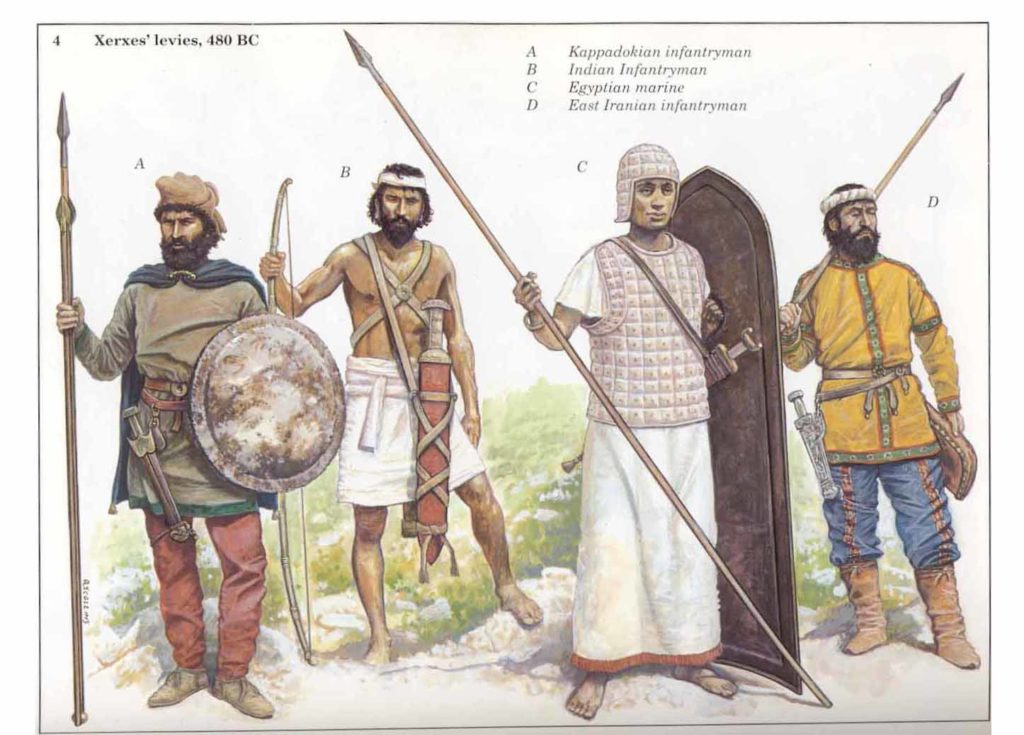
Xerxes troops: At the center, Egyptian marines (Osprey).
Back to Artemisium, the Allies made a conference. It was established given the odds they could not gamble the fate of Greece on another engagement and to hold the line the next day. Some wanted to withdraw immediately, other wanted to wait for new from Thermopylae. Themistocles ordered the slaughter and keep for themseves the Euboeans flocks, denying them to the Persian while Abronichus arrived from Thermopylae, telling them what happened at Thermopylae. There was no purpose in holding the area and the allies immediately voted to leave. Meawnile, they preserved at least half their force for a future engagement, not knowing if the Persians had repaired all their ships and how many were left.
The Allies withdrawned to Salamis. The Persians, seeing the place open to invasion, landed their troops and captured Phocis, Boeotia, and Attica. As a nightmare, their uncontested armies took Athens, pillaged and burnt. They however found few inhabitants to slaughter or enslave. Most already fled since days. The staff however estimated the job “was not done” as soon as there was navy and an army that needed to be soundly and decisively defeated. They prepared to follow the greeks at Salamis, later this year, in 480 BC. However, meanwhile Xerxes did not wanted to stay all the winter in Greece and withdrew his army. Mardonius was left to “finish off” the Greeks once and for all, quickly. They never could have guess Plataea and Salamis, superb examples of fortitude in the “fortunes of war”…
Aftermath of the battle
Artemisium has been a standoff, as the battle of Themopylae took place. The defeat of the first, as soon as it was learnt, trigerred a strategic retreat. Leaving the place to the Persians, which did not believed it at first and thought of an ambush, the latter saw it as a victory. This was not even a pyrrhic victory for the Greeks as they achieved nothing, but delaying for three days a landing in this area. Loosing half their forces was in any case a crippling blow, moreover given the size of the fleet that remained on the other side, but at least they measured their opponent strength and weaknesses.
The Greek fleet went off the coast of Attica to assist evacuating the remaining Athenians and Themistocles stopped en route to engrave inscriptions addressed to the Ionian Greeks, as they would probably stop there for the night, asking them to defect, as reported by Herodotus. The Allies on land, the bulk of which were Peloponnesian, prepared to defend the Isthmus of Corinth, cut the only road leading through and erected a wall there. Like at Thermopylae, they prepared for a last stand. This required an naval blockade across the Saronic Gulf to be effective. Themistocles however contested this strategy and persuaded the Allies to try to get a decisive victory by Luring the Persians into the Straits of Salamis, a natural bottleneck where they could negate the superiority of their fleet. Basically this was Thermopylae at sea.
The Battle: locations, leaders and respective forces
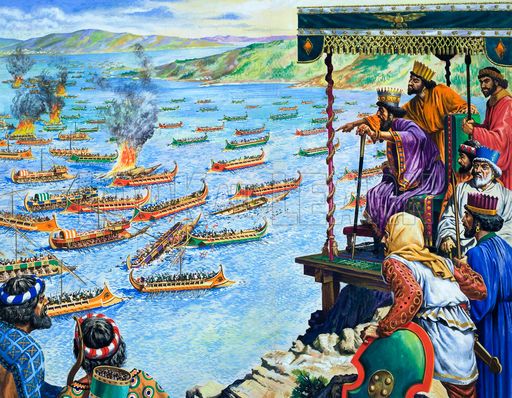
Prelude and Development
The Allied fleet as seen before, sailed from Artemisium to Salamis, in order to assist evacuatiing the last Athenians en route while Themistocles left inscriptions for the Ionian Greek. They learnt about how the Persian army ransacked Boeotian cities such as Plataea and Thespiae, which decided to resist, and marched on Athens, strengthening their resolve. The strategy to block the isthmus of Corinth soon appeared flowed unless the fleet was able to prevent a Persian landing in the Saronic Gulf. Naval commander Adeimantus asked the fleet to asembled off the coast of the Isthmus but Themistocles vehemently argued against it. He wanted a more offensive strategy rather than another passive stand-off, remembering the audience the losses at Artemisium. As he said, he wanted a “battle in conditions thats works to our advantage”. He eventually won the argument and the Allies remained off Salamis.
The battle time-line is contested by modern Historians. Herodotus is unclear about its date compared to the fall of Athens. It is generally admitted that at least three weeks passed in september after the battle of Artemisium. In addition, before going to Salamis, the Persian fleet needed to refit the ships and resupply. Xerxes held a war council at Phalerum, with Artemisia, queen of Halicarnassus, now commander of the elite naval squadron. She tried to convince him to wait for the Allies to surrender but Xerxes was convinced by his staff, which pressed for a decisive victory over what they thought as an half-vanquished fleet, divided and probably demoralized by now. Xerxes indeed knew perhaps by his spies, of the vivid discussion within the allied command as the Peloponnesians wanted to leave Salamis as they still could. The alleged rift however was perhaps a ruse, propagated be double crossing agent, just in order to lure the Persians by Themistocles. Whatever the case, the Allies waited quite patiently off Salamis for at least a week, using this time to refit the ship, supply and train. Meanwhile, the Persian army was seen marching against the Isthmus, perhaps to tempt the fleet and lure it to battle in turn.
Eventually Xerxes ordered his fleet patrol off the coast of Salamis, and to block the southern pass, only possible exit for the allies. At dusk, these ships were ordered to withdraw, perhaps again, to lure out the Greeks into open sea battle, where the fleet’s numbers played in it advantage. In the evening, Themistocles sent a servant, Sicinnus, to Xerxes, as a fake defector. He brings news from Themistocles that he was “on the king’s side and prefers that your affairs prevail, not the Hellenes” as reported Herodotus.
Themistocles went to say the allied command was in-fighting, and the Peloponnesians planned leave by nightfall. This clearly tempted the Persians, as they needed to block the straits as soon as possible.
With this subterfuge, Themistocles lured the Persian fleet into the Straits, and comforted Xerxes in his opinion. His staff knew that if the Athenian defected, and the Pelopponesian ships gone, there was no hope for the remainder of the fleet to stand his might. This very evening, the entire Persian fleet sailed out while Xerxes ordered his throne to be set up on the slopes of Mount Aigaleo, overlooking the straits to witness the battle at dawn, observing his commander’s banners are colors to see those who performed best. He allegedly said about Artemisia “my men has become women and my women, men”. Still according to Herodotus, the Allies meanwhile were still debating and the Peloponnesians still wanted evacuating. However, Aristides, the exiled Athenian general which previously joined the Persians went to the allied camp unexpected, followed by some deserters. He reported the deployment of the Persian fleet, which convinced the Peloponnesians to stay as it was too late to escape now. Themistocles’s stratagem ensured the Greeks stayed rested this night while the Persians fleet sailed all night, searching for an elusive alleged Greek evacuation. The next morning, they were into the straits, tired, and spotted the Greek fleet ranged in battle…
Tactics and technologies of the time
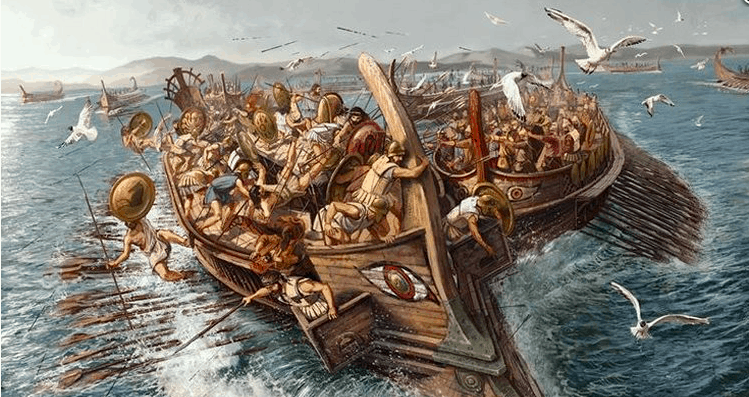
Battle formations
In open sea the Greeks were generally led by the commander’s ship and at first sight of the enemy, turn to starboard or port to form a battle line the ship being side by side, facing the enemy, contrary to the classic black powder age when ships presented their broadside. This abreast formation was meant to protect mutually the ships flanks, and basically was a repeat of hoplite phalanx at sea. It was both offensive and defensive and they could advance am forward, before picking their target and manoeuver for ramming. Defensively, this was a wall of rams presented to the enemy, and if necessary the ship would close together. A variation of it existed in case of numerical superiority of the enemy and the periplous manoeuver: No name is attached to it, but it was basically a tight circle, with the prows facing outwards. The vulnerable sides and stern were therefore in the inner circle.
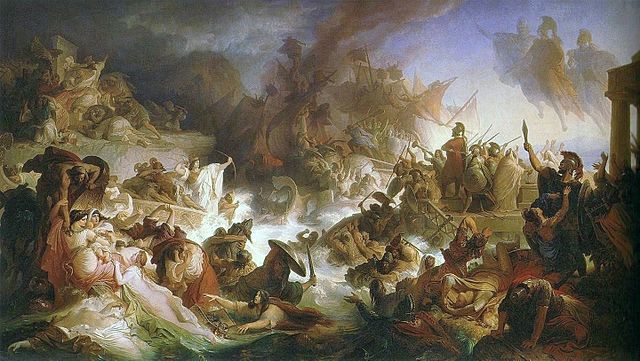
A 1868 painting by Wilhelm von Kaulbach of Salamis
Diekplous, the “arrow” formation
This abreast formation, with variation like the crescent and arrow, was used in most naval battles, except Naupactus. There, the Athenian navy was attacked before it could transition. This Greek battle formation was also so successful the Persians used it, and to stay ahead, the Greek navy needed to improve and search for new tactics.
The diekplous was a breakthrough manoeuver: A line was formed, a kind of arrow point, with ships, the lead thips at its head and others behind, to infiltrate the enemy line-of-battle. This was a line abreast which penetrated the enemy line, then would turn around for ramming.
The diekplous was considered quite effective and won the day at Lade, Chios, and Side. Counter tactics against it were soon developed, like retreating into a tight circle (as seen above). The “hedgehog counter-formation”. The tight circle prevented infiltrations. The circle could even be refine by leaving a few reserve ships that will row and ram any ship that would eventually break through. This was Themistocles formation at Artemisium, but despite of this, the circle began to disintegrate and turn to a general melee.
Periplous, the “crescent” formation
The periplous consisted in “sailing around” the enemy’s line, to expose the enemy’s stern for easy ramming. It was used at Artemisium, and was often a question of numbers superiority, which was the case here for the Persians. Thucydides also shown a good example at the second battle between the Athenians and Peloponnesians in the Gulf of Corinth. A single Athenian triere was pursued by a Peloponnesian triere until it circled around a merchant ship, and rammed the Peloponnesian vessel after coming out from behind. It was faster, a key element in this manoeuvre to succeed.
Ram evolved, from a fully wooden spear, to trireme’s early rams, which were essentually a large piece of timber, reinforced by bows pieces, and sheathed in an envelope of bronze. It was therefore not made entirely in bronze. This happened as the ships became heavier, not to shatter the wood. Of course ramming tactics imposed a skilled crew, rowing cadence and strength needed to be finely adjusted, which imposed professionals. Not only the ship needed to be very fast to have momentum for the schock, but also quickly disengage; not to be caught in the wreck. The stern was often the obvious target. The steering oars were indeed located there. Another tactic, if the other ship turned to avoid ramming, was to shear its flanks fast, breaking its rows in the process. This required the rowers to fast retreating the long rows inside the hull, not a small feat in a short notice. Centuries later, the Romans, and Hellenistic powers would just break the oars at a distance using catapults and ballistae. When the ship was nearly immobilized it was easy to ram and board.
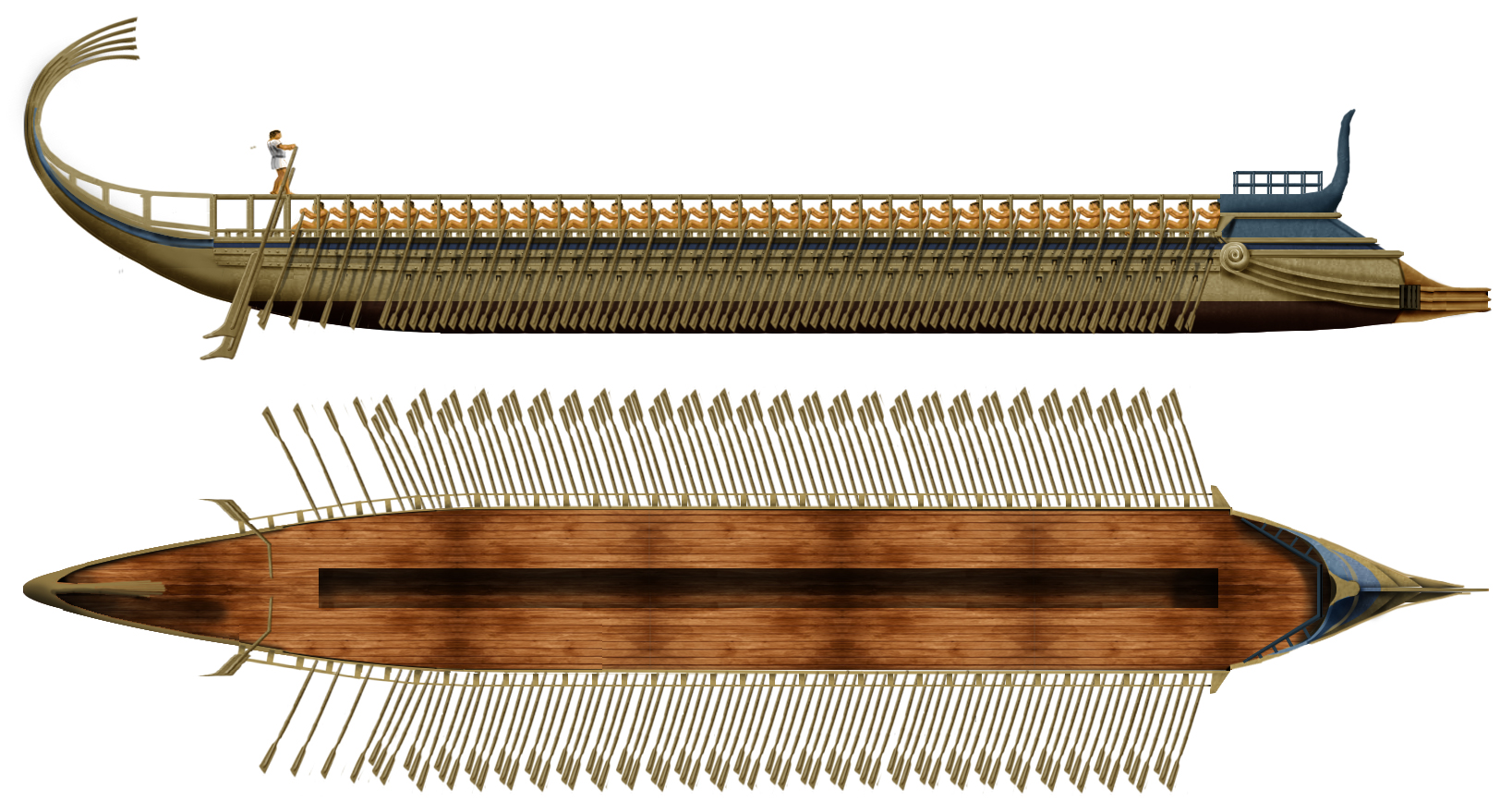
NE rendition of a typical Greek triere at Salamis, from a coin prow depiction
Marines and archers
The limited size of early penteconteroi and assimilar ships were narrow and combatants were a few, together at the front platform in general. Archers were systematically place there, protected by the bow’s structure. Heavier troops could be carried, just a few. Rowers were not supposed to fight. This was in stark contrast to the Pirates, which rowers were also all combatants. this way, it was easy to overcome ant vessel. With the arrival of the triere, fitted with a cover deck, a limited number of troops could be carried, limited to avoid the ships to be unstable. A fully-cladded heavy hoplite with its helmet, bronze body armor, bronze-backed aspis, weapons, greaves, could be 80 to 90 kgs of we assume the average Greek of the time was 1.65 m and 75 kgs.
Ten hoplites would represent close to one ton, placed way above the gravity point of the ship. Not something to take lightly. Stability was compensated however by the numeous oars at sea either side fortunately. The ships’ gravity also included the mast and sail, more so if the latter was soaked with seawater in heavy weather, and the crew dedicated to it, about ten men in a triere. It was not uncommon therefore to load more Marines troops “epibatai” on board when the rigging was absent, which was systematic before a battle. With time, Epibatai were developed specifically to board enemy ship and close combat. They differed both in their equipment and training from hoplites. The latter were tailored for a large battleline, defensive and offisensive, however on a narrow ship, there was no place for such tactic, and Epibatai needed to operate individually, and be fast and agile. They were lighter, greaves were optional or absent, but they had helmet and body armor, and an aspsis for protection (or hoplon, the classic bowl-shaped shield, one meter in diameter).
More importantly their armament differed: Instead of a three meters long dory, better suited for defense, they had one of several javelins instead, to throw before boarding. Their main melee weapon was therefore the sword, which could be either a straight one (xyphos), or more likely a curved one, eithe the Kopis or Machaira. The latter was cumbersome and mostly used by cavalry as a saber, so the lighter kopis would have been mainstream.
The kopis was an amazing sword related to many other slashing-first weapons of classical antiquity: The Spanish Falcata was the closest (perhaps derived from the kopis) and closest to us, the kukhri of the Nepalese. It had a protected handle, and had single curved edge, pitched forward towards the point. The “meat” of the sword was at 2/3 of its edge, it gets slimmer near the handguard. This way, its weight was concentrated forward, with excellent balance for slashing, but still able to do thrusting as well. The weight balance gave it the same force as any machete, alsmot as efficient as an axe. It was an in-between, and this was why it was beloved for melee combat. In time, during of after the Pelopponesian war, Marine troops adopted the lighter and more manageable thyreos as their main shield, ovale-shaped, thus offering better individual protection.
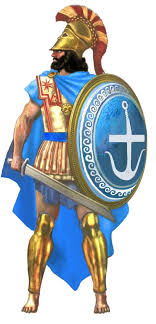 During the Peloponnesian War, the proportion was 4 archers and 10 Epibatai on deck, but this varied, Cimon for exemple reported as much as forty marines per triere during the battle of Eurymedon in 466 during the delian league war against the Persians. This figure became commonplace as war galleys became heavier ‘kataphraktoi’ in the latter hellenistic period. Due to their stronger construction and full deck, with shields attached to its sides, they could support much more troops and throwing weapons as well, even towers. Some Ptolemaic egyptian prestige ships had nearly a thousand troops on board.
During the Peloponnesian War, the proportion was 4 archers and 10 Epibatai on deck, but this varied, Cimon for exemple reported as much as forty marines per triere during the battle of Eurymedon in 466 during the delian league war against the Persians. This figure became commonplace as war galleys became heavier ‘kataphraktoi’ in the latter hellenistic period. Due to their stronger construction and full deck, with shields attached to its sides, they could support much more troops and throwing weapons as well, even towers. Some Ptolemaic egyptian prestige ships had nearly a thousand troops on board.
The use of more Marine was dictated by the battle, in open sea and for manoeuvers, a commander wuuld want less marine troops to keep his ships light and agile. If the battle was in confined waters, more marines were carried for boarding. Essentally this was a land battle at sea. The rookie Romans during the first punic war avoid ramming tactics, they trusted their infantry instead and just found ways to board enemy ships by all means, while being protected from ramming themselves, making them slow and heavy.
An important point, worth repeating, was that when trieres were departing their harbor for battle, the same day, they did so without rigging and the men responsible for it. So all depictions of naval battles showing sailing galleys trying to ram each other is plain wrong.
Archers were also important in the opening, ramming phase, of the battle, and during the boarding phase as well. They also could pick off officers during the battle. Cretans mercenaries had the best range, effective at 160–170 meters and well beyond with the recurved composite bows of the Scythians, which could fire poisoned or flaming arrows as well.
Greek ships & tactics
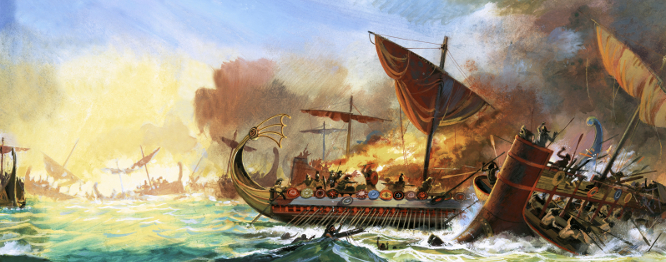
Another innacrate depiction of a naval battle between galleys. They indeed displays their full rigging, something which would only happen if the fleet was in transit, then caught by surprise.
The trieres used a variety of tactics, but in 480 BC they were still in their infancy. Athens just ordered 200 trieres thanks to an influx of cash, and for the first time, numbers allowed large scale manoeuvers and tactical formations to be used. Prior to the triere standard, the fleets were composed of a variety of vessels, ranging from a few triere to many dieres, penteconters, and small moneres. They had different speeds and agility, and the lightest could not ram, thy were too light for this. So combat as it happened during the Ionian revolt at Lade probably including long range archery duels, then some ramming, and a general melee boarding contest as distances closed. Little is known about details of the fight, but fire, after the ram, was the ship’s worst nightmare and it’s not far fetch to think naphta pots and flaming arrows were used. Due to their high positive buoyancy, which imposed a lot of ballasting to lower the center of gravity, these ships never sank. They just partly disagregated for those rammed and broken, but most often they were captured. It was not uncommon for them to change hands several times. We don’t have precise informations about their length of service, but as long as they were kept dry when not used, and well maintained, they could last for dozens of years, depending of their building quality and the woods and process used.
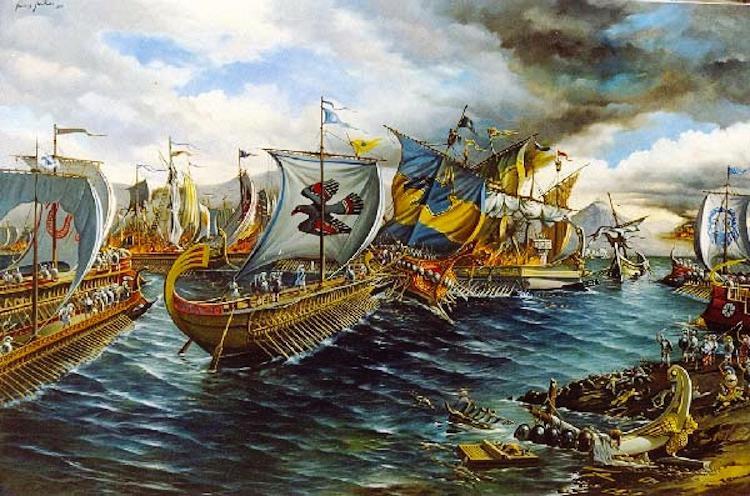
Fighting was the role of marine troops. Traditionally, archers were placed at the bow, relatively protected, and typical Athenian trieres of the 5th century BC carried a few warriors, up to 20 for the admiral ship if there was one. Typically in Salamis, 14 hoplites and 4 archers, the latter being usually Scythian mercenaries, which had great range and could be fierce warriors in melee with their shield and sagaris (battle axe). This meant at Artemisium, a potential of 1,080 archers (scythians and cretans), and some 3,800 hoplites, finely equipped and well trained with a sword, javelin and spear as should be epibatai. Practice could diverged however from fleet to fleet. The figure above is related to the Athenians, but Herodotus mention the Chiots trieres (City-state of Chios) carried 40 hoplites. The deck surely was large enough to accomodate them, but with their hevy equipments they would have compromised the ships’s stability, so these should have been wider, lower vessels, biremes or hybrids at the battle of Lade. Opposite them, the Persians had similar figures.
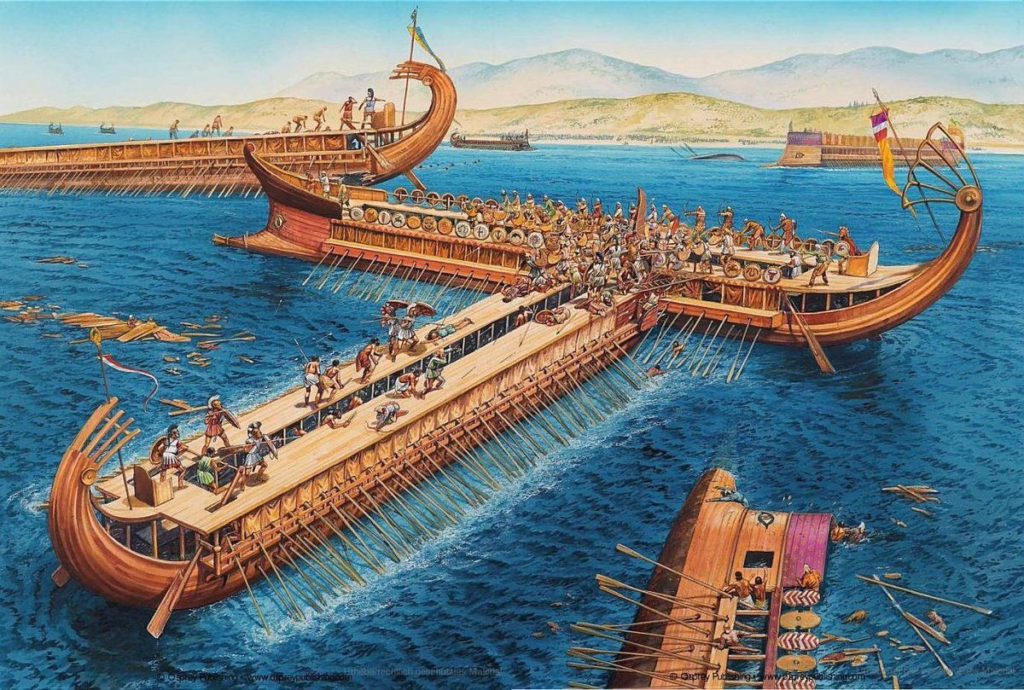
Persian ships & tactics
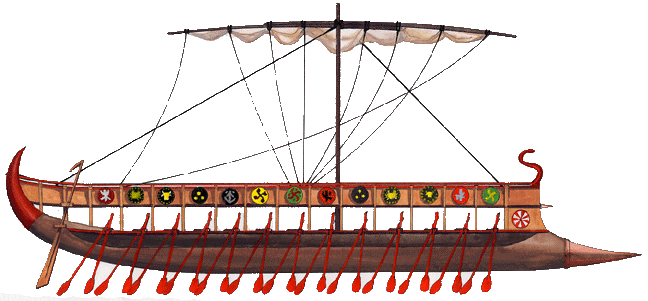
A phoenician two-stage diere, as shown in Assurpanipal’s bas relief. A precious depiction which showed how to stack combatants in a diere, probably all armed with arrows and javelins. This makes us wonder how it was possible to keep stability in this configuration. In any case, this gave the Assyrians, which benefited from their Poenician client-state navy, and edge in 600-700 BC. They had a ram-like point (probably decorative) and were low draught to carry horses, chariots and supplies across rivers.
In 480 BC howver, naval technology went ahead and both the Egyptian and Phoenician ships were more modern, not far away from Greek constructions, which they probably inspired. The real newcomers were the Atenians and their brand new lighweight galleys, innovative for their time.
Precise depictions are found in book 7 of Herodotus “histories”, for the ships in the Persian navy, their armaments of the marines troops (89-98), so just let’s have it plain, and then interpret the data (English translation by A. D. Godley. Cambridge. Harvard University Press. 1920. ):
“The number of the triremes was twelve hundred and seven, and they were furnished by the following: the Phoenicians with the Syrians of Palestine furnished three hundred; for their equipment, they had on their heads helmets very close to the Greek in style; they wore linen breastplates, and carried shields without rims, and javelins.
[2] These Phoenicians formerly dwelt, as they themselves say, by the Red Sea; they crossed from there and now inhabit the seacoast of Syria. This part of Syria as far as Egypt is all called Palestine.
[3] The Egyptians furnished two hundred ships. They wore woven helmets and carried hollow shields with broad rims, and spears for sea-warfare, and great battle-axes. Most of them wore cuirasses and carried long swords.
Such was their armor. The Cyprians furnished a hundred and fifty ships; for their equipment, their princes wore turbans wrapped around their heads, and the people wore tunics, but in all else they were like the Greeks. These are their tribes:1 some are from Salamis and Athens, some from Arcadia, some from Cythnus, some from Phoenice, and some from Ethiopia, as the Cyprians themselves say.
The Cilicians furnished a hundred ships. They also wore on their heads their native helmets, carried bucklers of raw oxhide for shields, and were clad in woollen tunics; each had two javelins and a sword very close in style to the knives of Egypt. These Cilicians were formerly called Hypachaei, and took their name from Cilix son of Agenor, a Phoenician.1 The Pamphylians furnished a hundred ships: they were armed like the Greeks. These Pamphylians are descended from the Trojans of the diaspora who followed Amphilochus and Calchas.
The Lycians furnished fifty ships; they wore cuirasses and greaves, and carried cornel-wood bows and unfeathered arrows and javelins; goat-skins hung from their shoulders, and they wore on their heads caps crowned with feathers; they also had daggers and scimitars. The Lycians are from Crete and were once called Termilae; they took their name from Lycus son of Pandion, an Athenian.
The Dorians of Asia furnished thirty ships; their armor was Greek; they are of Peloponnesian descent. The Carians furnished seventy ships; they had scimitars and daggers, but the rest of their equipment was Greek. I have said in the beginning of my history1 what they were formerly called.
The Ionians furnished a hundred ships; their equipment was like the Greek. These Ionians, as long as they were in the Peloponnese, dwelt in what is now called Achaia, and before Danaus and Xuthus came to the Peloponnese, as the Greeks say, they were called Aegialian Pelasgians.1 They were named Ionians after Ion the son of Xuthus.
The islanders provided seventeen ships and were armed like Greeks; they were also of Pelasgian stock, which was later called Ionian for the same reason as were the Ionians of the twelve cities,1 who came from Athens. The Aeolians furnished sixty ships and were equipped like Greeks; formerly they were called Pelasgian, as the Greek story goes.
1 Herodotus generally uses the name “Pelasgian” for the oldest known population of Greece
[2] Of the people of the Hellespont, the people of Abydos had been charged by the king to remain at home and guard the bridges; the rest of the people from Pontus who came with the army furnished a hundred ships and were equipped like Greeks. They were settlers from the Ionians and Dorians.
Persians and Medes and Sacae* served as soldiers on all the ships. The most seaworthy ships were furnished by the Phoenicians, and among them by the Sidonians. All of these, as with those who were marshalled in the infantry, each had their native leaders, whose names I do not record, since it is not necessary for the purpose of my history.
*Author’s note: Sacae are eastern scythians, also called “Royal Scythians”, armed the same way as the Greek Mercenaries, with long range double-recurved bows.
[2] The leaders of each nation are not worthy of mention, and every city of each nation had a leader of its own. These came not as generals but as slaves, like the rest of the expedition; I have already said who were the generals of supreme authority and the Persian commanders of each nation.
The admirals of the navy were Ariabignes, son of Darius, Prexaspes son of Aspathines, Megabazus, son of Megabates, and Achaemenes, son of Darius. Ariabignes, son of Darius and Gobryas’ daughter, was admiral of the Ionian and Carian fleet; the admiral of the Egyptians was Achaemenes, full brother of Xerxes; and the two others were admirals of the rest. The ships of thirty and of fifty oars, the light galleys, and the great transports for horses came to a total of three thousand all together.
After the admirals, the most famous of those on board were these: from Sidon, Tetramnestus son of Anysus; from Tyre, Matten son of Siromus; from Aradus, Merbalus son of Agbalus; from Cilicia, Syennesis son of Oromedon; from Lycia, Cyberniscus son of Sicas; from Cyprus, Gorgus son of Chersis and Timonax son of Timagoras; and from Caria, Histiaeus son of Tymnes, Pigres son of Hysseldomus, and Damasithymus son of Candaules.
I see no need to mention any of the other captains except Artemisia. I find it a great marvel that a woman went on the expedition against Hellas: after her husband died, she took over his tyranny, though she had a young son, and followed the army from youthful spirits and manliness, under no compulsion. [2] Artemisia was her name, and she was the daughter of Lygdamis; on her fathers’ side she was of Halicarnassian lineage, and on her mothers’ Cretan. She was the leader of the men of Halicarnassus and Cos and Nisyrus and Calydnos, and provided five ships.
[3] Her ships were reputed to be the best in the whole fleet after the ships of Sidon, and she gave the king the best advice of all his allies. The cities that I said she was the leader of are all of Dorian stock, as I can show, since the Halicarnassians are from Troezen, and the rest are from Epidaurus.
Here ends what I have said of the fleet. When his army had been numbered and marshalled, Xerxes desired to ride through and view it. Then he did this; as he rode in a chariot past the men of each nation, he questioned them while his scribes wrote it all down, until he had gone from one end to the other of the cavalry and infantry.”
Back to the source and what we can tell from it:
-Both the Phoenicians, equipped in the Greek style, and the Egyptians, with spears and battle axes, seemed to have been noted as dedicated marine troops. The rest of the combatants were equipped it seems like the land troops, therefore not specialized, not trained marine troops.
-“most seaworthy ships”, meaning probably large covered cargo ships for the auxiliary fleet and triere and dieres. The Phoenicians were the distant relatives the Carthaginians, inheriting a long and proud shipbuilding tradition.
-“ships of thirty and of fifty oars” meaning triaconters and pentaconters, small, old types of vessels
-“light ships”, presumably cisoconters and moneres of 10 oars and more. Smaller boats were a hazard in the Mediterranean, they probably came from nearby islands, or captured from coastal cities to carry plunder and supplies.
-3,000 ships seems enormous, but the largest part was not the “active fleet”, trieres and dieres seen at Salamis but essentially supply ships and transports, a naval “baggage train”.
-Horses were in dedicated ships, 5th century BC hippagogues.
-The king’s trusted admirals were men from the court, appointed to regional fleets for which loyalty has been dubious in the case of the Ionians in particular
-Artemisia was remarked by Xerxes, as a woman in charge of a small fleet, and became a wise advisor, but he did not made her his supreme naval commander or even appointed her to a large squadron. Five ships was certainly not a game changer in this battle, how excellent they were. Her prominence in Herodotus’s work was probably a fascination, as this was unheard of for “civilized” greeks to have women appointed to military matters. The Sacae also had many women in their ranks, at least back home, so this was not unheard of to the Persians. The matter was again underlined with Polybius decribing the warrior queen Teuta of the illyrians. A fascination probably mixed with terror inherited from tales of the amazons.
The Greeks had some reasons to fear this engagement, as they had only 378 “triremes” recounted as 371, since the Aeginetans “had other manned ships, sending at Salamis their thirty most seaworthy”. Two more ships defected to the Greeks, including one before Salamis, making 373. Athenian playwright Aeschylus cited 310 triremes, without the Athenian ships and Ctesias 110 triremes, Hyperides, 220. In any case, Themistocles was under overall command, but Spartan Eurybiades was elected his superior at the congress of 481 BC. The various city states kept their own command with some degree of independence.
On the Persian side, the fleet which initially had 1,207 “triremes” lost one third off the coast of Magnesia, and 200 more off the coast of Euboea plus 50 ships at the Battle of Artemisium. Losses were replaced according to Herodotus, but amounted to only 120 ships from Thrace and nearby islands. Aeschylus (present at Salamis) claimed to see 1,207 vessels (still Homer’s Troy expedition’s fleet), and for his 207 were “fast ships” (so probably trieres), while Diodorus and Lysias also claimed 1,200 ships were assembled at Doriskos, a figure confirmed by Ephorus, but Ctesias talked of 1,000 ships, like Plato, “1000 and more”. This number 1,207 was recorded already in 472 BC, and from then the Greeks really thought they faced that many war vessels. Some modern historians accept ths figure as an initial figure, cited 600 warships, and some accept a figure going up to 800 coherent with the figure left after Artemisium, around 550, added with 120 reinforcements.
The battle
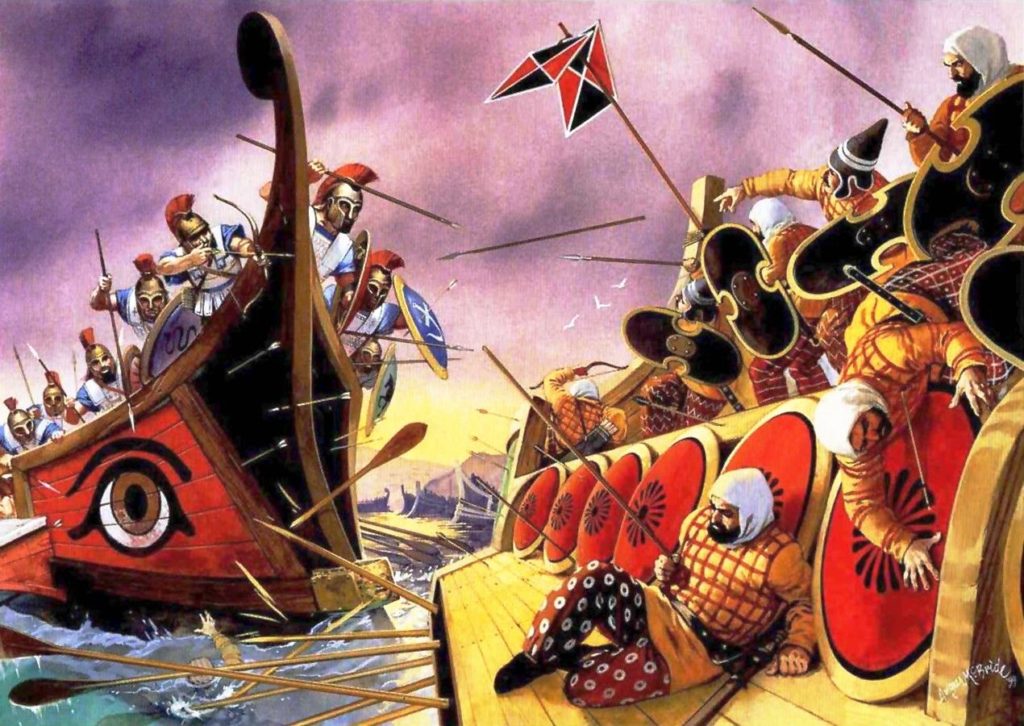
Herodotus left us with a confused timeline, presenting the battle as though it happened right after the capture of Athens, but logically they would have needed two or three weeks to capture the city, refit and resupply properly. Xerxes war council at Phalerum failed to convince him to wait for the Allies surrender; but the staff presse for an attack, and thanks to Themistocles clever “fake news”, luring eventually the Persian fleet into the Straits. Xerxes had its throne setup in the slopes of Mount Aigaleo overlook the battle, and so it started.
The Persian strategy planned the conquest of Greece in a single campaigning season, before the winter. The Greeks knew their limited forces left them with few options but to take the best defensive spots, keep the Persians in the field for as long as possible. Xerxes never anticipated such resistance and now time played against him, giving cluse why he refused the attentist position Artimisia to avoid bloodshed. One reason was his huge army’s support was not infinite, and Thermopylae shown frontal assaults were pointless gainst well protected hoplites. The Greeks repetead this stand at the Isthmus, so the Greeks needed to be outflanked, requiring the Persian navy to deal with the Allied navy first. And possibly ask directly for a Greek surrender and conclude his campaign that season. On Themistocles side, he hope to crippled the Persian fleet enough to avoid a flaking landing, thus constraining the Persians to leave.
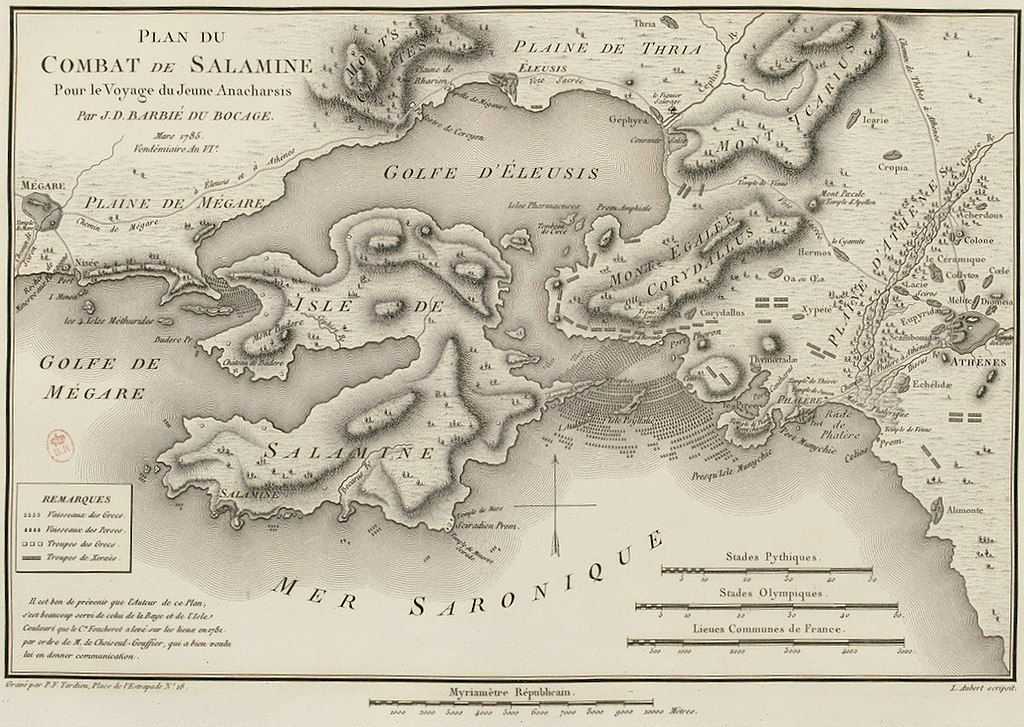
A 1798 map engraving of the battle, made for Diderot’s encyclopediae by the illustrator Barthélémy.
The Persians therefore, had really no choice but to face the Greek fleet at Salamis. The Persian fleet’s size in addition allowed to bottle up the Allied fleet in the straits, at the same time landing troops in the Peloponnese. Outnumbering the Allies was an obvious advantage in addition to probably better crews (The Phoenicians notably) while Athenians were “rookie” and it’s not impossible to think many other city-states built triremes during this war, and were equally inexperienced. Nevertheless these Athenian triremes were light and tailored for ramming.
When the Persioan fleet deployed, it started diekplous (a breakthrough) due to the narrows. There are various interpretations of the manoeuver, either creating a single column and penetrate the center of the Greek line or simply rowing into gaps between enemy ships. The better Persian crews would have been more likely to do it this way, having theeir Phoenicians and Egyptians in the first line. The Greek fleet had the Persians where they wanted, into a constricted area negate their numerical superiority. Straits of Salamis offered an even more constricted approach, so much so that archers could pepper the Persians from the shore. The Persians took the bait, confident of the Allied collapse, but it proved a disastrous mistake.
There are still cinfusing tales of how precisely the events unfolds. The Allied fleet had the Athenians on the left, Spartans (or Megareans and Aeginetians) on the left, and all the other contingents in the center. This was sensible disposition as les resolute city-states could no longer back down, frame as they were, and at the same time, both the Athenians and Spartans were more likely to defeat an attempt of flanking. The Allied fleet probably formed two ranks, as a single line just would not fit in the narrow. This line ran north–south, probably from a point near modern-day Saint George’s Islet and south point off the coast of Cape Vavari. Diodorus however suggested a line running east–west spanning the straits between Salamis and Mount Aigaleo, dubious as one flank was controlled by the Persians, and archers could have been send there.
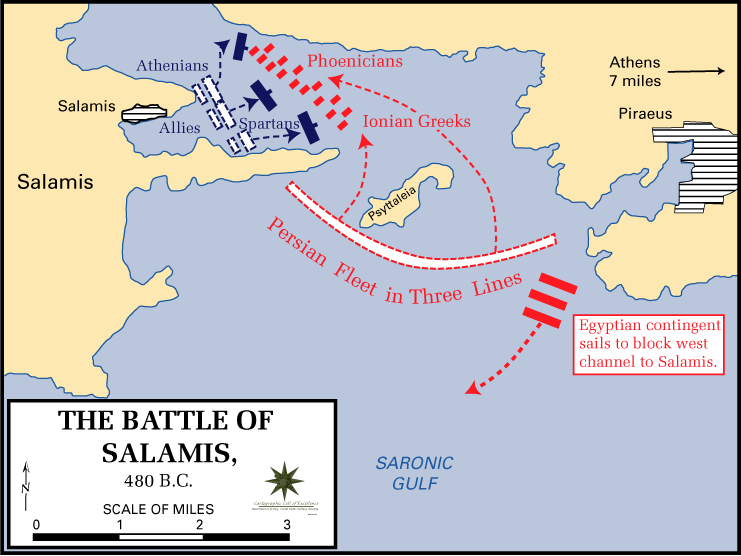
Map showing the Persian fleet pivoting to meet the Greeks in the narrows (cc)
The Persian fleet much probably sent a fleet to block the exit before the battle, but catching the allies by night was complicated due to the constricted waters and lack of knowledge of these. Blocking the exit and entering the straits in daylight was more sensible. The Persians had their fleet placed off the tip of Cape Vavari, from an east–west alignment blocking the exit to a north–south alignment and formed into three ranks according to Aeschylus. The Phoenicians were on the right, close to Mount Aigaleo, the Ionians on the left and the others in the centre.
For Diodorus this was the Egyptian fleet which was chosen to circumnavigate Salamis and block the northern exit, but not Herodotus, at the contrary cited their presence in the main battle. Xerxes positioned also 400 troops on the island of Psyttaleia, in the middle of the straits exit possibly archers and some infantry to fell on shipwreck and grounding ships’s crews.
The Persians waited until daylight whereas the Greeks spend the night to prepare for the battle, their morale roused after a speech by Themistocles, and they sailed at dawn to take their positions. Soon, both fleets were close enough for the Persians to hear the Greeks singing their paean according to Aeschylus. Herodotus reported that the first engagements started when the Corinthians hoisted their sails to sail away from the battle northwards, denied by others. They might have been -if true- a decoy to scout the northern exit if the Egyptians were coming, or their move incited the Persians to approach more decisively believing the Allied fleet was in effect, disintegrating. This was no defection, as the Corinthians were back.
Due to their large scale manoeuver in three columns into the narrows, the complicated manoeuver saw the Persians disorganised and cramped, to see the Greeks well lined up and ready to attack. But the latter appeared to keep their ships back, to gain better position and time until the early morning wind according to one author. Herodotus embelished that by claiming that when the Greeks seemed to back away, a woman appeared and ask them “Madmen, how far will ye yet back your ships?” However he also described a single surging forward, ramming the nearest Persian ship, commanded by Athenian Ameinias of Pallene. The Aeginetans claimed they were first. In any case, as a rally cry, the whole Greek line followed and headed at force rowing towards the disordered Persian battle line.
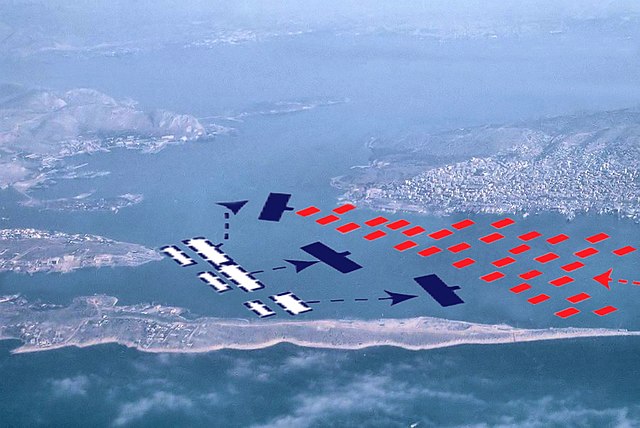
A modern aerial view of Salamis and the supposed positions of the fleets.
Few details survives of what exactly happened during the battle and no one could have an enlightened overview for the entire battle. Ramming or shearing off banks of oars was difficult, due to the confined space, and the initial maneouver probably worked, but soon as it became more crowded with Persian ships advancing behind, boarding marines became the next step. Will a melee developming, this probably turned to a huge melee from deck to deck. The first Persian line was pushed back and rereated or collided with the advancing second and third lines, adding to the confusion and clogging their own movements. Thus, the manoeuvers and tactics on the Persians were not impossible. The Greek left advanced fast and apparently the Persian admiral Ariabignes, brother of Xerxes was killed*, leading to demoralization and further confusion. He was crucially heading the Phoenician squadrons, which, as reported, seemed to have been pushed back against the coast. The centre saw the Greeks forms a wedge, organized for a kind of Diekplous, and pushed their way through Persians lines. It went so far they allegedly split the fleet in two.
*Plutarch said he was killed by by Ameinias and Socles of Pallene as he attempted to board on their ship, speared and thrust him into the sea under the eyes of the Persians, as also that Artemisia recognized his body floating among shipwrecks, bringing it back to Xerxes.
“Ariamenes, admiral to Xerxes, a brave man and by far the best and worthiest of the king’s brothers, was seen throwing darts and shooting arrows from his huge galley, as from the walls of a castle. Aminias the Decelean and Sosicles the Pedian [Socles of Palene in reality], who sailed in the same vessel, upon the ships meeting stem to stem, and transfixing each the other with their brazen prows, so that they were fastened together, when Ariamenes attempted to board theirs, ran at him with their pikes, and thrust him into the sea…”
Note: This would have been a foolhardy decision during the battle, so likely it happened afterwards.
By then, she commanded the Carian contingent and was busy shooting arrows as reported by Herodotus. Artemisia was also pursued by Ameinias of Pallene which opened hostilities, andn still for Herodotus, in her will to escape, rammed another Persian vessel, probably blocking her way out (Needs caution). This move convinced she was an ally (an argument in favor of relativily similar ships and hard to read recoignition signs), convincing her pursuer she was an ally and letting her go.
Xerxes, allegedly spotted what happened and believed she had successfully attacked a Greek ship, which, compared to the poor performance of his other captains famously commented “My men have become women, and my women men”. The victim of this ramming was a Calyndian ship, with the king Damasithymos on board, and the entire crew disappeared (…).
“When the affairs of the king had come to great confusion, at this crisis a ship of Artemisia was being pursued by an Athenian ship; and as she was not able to escape, for in front of her were other ships of her own side, while her ship, as it chanced, was furthest advanced towards the enemy, she resolved what she would do, and it proved also much to her advantage to have done so. While she was being pursued by the Athenian ship she charged with full career against a ship of her own side manned by Calyndians and in which the king of the Calyndians Damasithymos was embarked.”
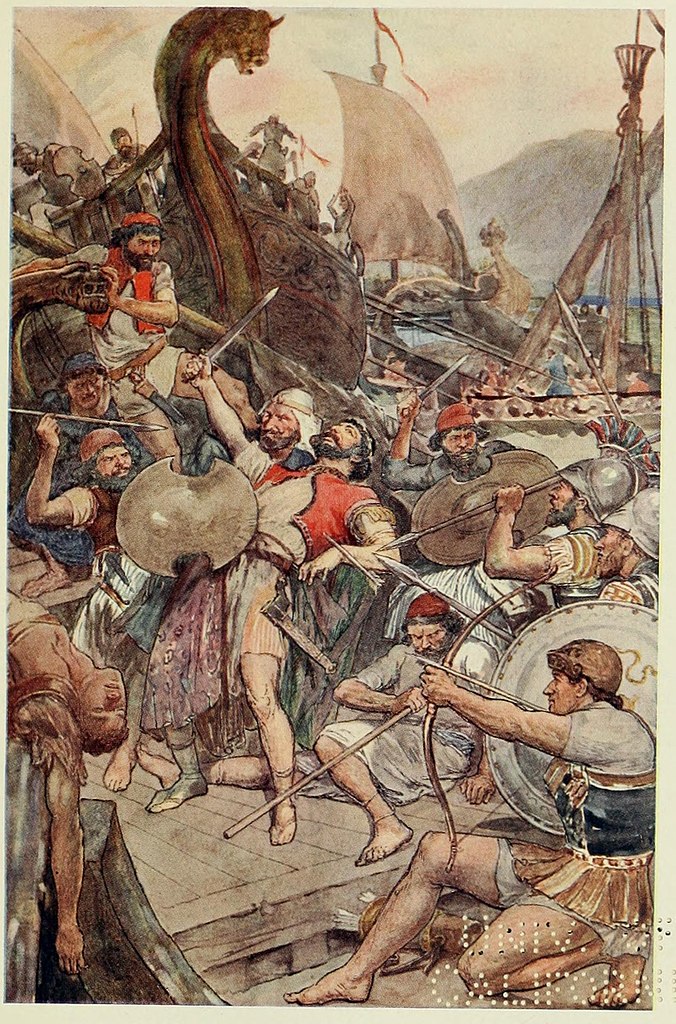
William Rainey, Death of the Persian admiral at Salamis (1870-80)
As the Greek breakthrough seemed to work, the Persian fleet started to retreat towards Phalerum, ambushed by the Aeginetans as they left the Straits, still according to Herodotus. The remaining ships limped back to Phalerum, under the protection of the Persian army. Athenian general Aristides as reported, sailed across to Psyttaleia with hoplites to finish off the garrison. Exact Persian casualties are unknown, but Herodotus claimed that in 479 BC, the Persian fleet was reduced to 300 triremes. If true, this was a staggering loss.
-First off, not all the Persian fleet was engaged, there was indeed perhaps a diversion fleet on the other side of the strait to block it, which for whatever reason did not came in time (if it existed).
-Second, ships were so cramped that the rear lines and those on the flanks perhaps never seen the Greeks, which basically were in the center of it;
-These ships seeing the development of the battle probably retreated
-Many Phoenician ships as reported by Herodotus, simply were beached and grounded on the coast after their admiral was killed.
-Still according to Herodotus, the Persians did not know how to swim and many drawn.
In any case, Xerxes saw the carnage from Mount Aigaleo and later received testimonies of some ship-wrecked Phoenician captains trying to blame the Ionians for cowardice, which ios not excluded given what Themistocles did before. Xerxes was not convinced apparently of this as he witnessed a Ionian ship capturing an Aeginetan one, beheaded them for slandering “more noble men”. For Diodorus this punishment was resented by the Phoenicians which lef his fleet and sailed to Asia at nightfall.
After Salamis: The Greeks strikes back (479-478)
As the battle ended, the Peloponnesian Allies also would try to lure Mardonius to battle, marching towards him in Attica. The latter avoided the fight, luring them in turn in open terrain for his cavalry to play its part. Both armies met near Plataea and engaged in a cataclismic clash in August 479 BC. There, the Greeks won a decisive victory, which ended all hopes of conquest while at the same time at Mycale, the fleet engaged what was Persian ships escaped from Salamis, and crushed them. With this double strike the war ended. No further invasion would be mounted for years a this point, at least under Xerxes. This changed the fate, not only of Greece, which would engage in a long and bloody war for or against Athens and its Delian league, but the western world, and democracy. The Greeks and Persians would fight again in what was called the Delian league wars, including a major naval battle, at the Eurymedon.
On March 17, 2017, archaeologists announced they discovered submerged remains of the Greek anchorage prior to the Battle, and ancient mooring site on the island of Salamis, near Ambelaki-Kynosaurus today. A monument was erected at Kynosoura peninsula on Salamis Island by sculptor Achilleas Vasileiou, and a column
How Salamis compares to other naval battles of the time ?
Sources/read more
Herodotus’ Histories, Thucydides, Xenophon, Polybius
http://www.usu.edu/markdamen/1320Hist&Civ/chapters/02HEROD.htm
http://www.perseus.tufts.edu/hopper/text?doc=Perseus%3Atext%3A1999.01.0126%3Abook%3D7%3Achapter%3D100%3Asection%3D3
https://www.reed.edu/humanities/hum110/Hdt/Hdt7.html
https://referenceworks.brillonline.com/entries/brill-s-new-pauly/epibatai-e331750
https://alchetron.com/Olympias-(trireme)
The models corner

Zvezda 500788514 1:72 Greek Triere
-Envy scale models 1:72 (hand built and painted)
-Dusek ships kits 1:72
-Amati 1:35 Bireme Salamis
Books
-Salamis – Christian Cameron
-Charles River editors – The battle of Salamis
–The wooden walls that saved greece – MMD-Squadron Signal
-The Battle of Salamis: The Naval Encounter that Saved Greece – and Western Civilization by Barry Strauss
-Lords of the Sea: The Epic Story of the Athenian Navy and the Birth of Democracy by John R. Hal
-Salamis 480 BC – the campagn which saved greece, osprey Publishing, W. Shepherd, P. Denis
-Osprey New Vanguard – Ancient Greek Warships – Nic Fields, Peter Bull
-Osprey wargame: Poseidon’s warriors – John Lambshead
-The Greco-Persian wars – Peter Green
Documentaries:
see also: BBC Podcast
Bilge mode ?
//www.youtube.com/watch?v=B2fmBIrGxAY
//www.youtube.com/watch?v=aQ59EZyIC-w
//www.youtube.com/watch?v=2PSMQGCwMxo
//www.youtube.com/watch?v=3nesDUUYxkw
//www.youtube.com/watch?v=1QfqIQ45ywQ
//www.youtube.com/watch?v=Pr1eYVTOBcs
//www.youtube.com/watch?v=OuTcceJAq5Q
Movies:
-Engineering an Empire (2005–2007), Episode: Greece (2006). Docu.
-300: Zack Snyder’s Rise of an empire (from the comic, to take with a truck of salt)
Games:
https://store.steampowered.com/app/766460/Trireme_Commander/
“Trireme commander”, a simulator of the battle of Salamis
Activision’s Rome Total War II: Same, as part of the global strategy game

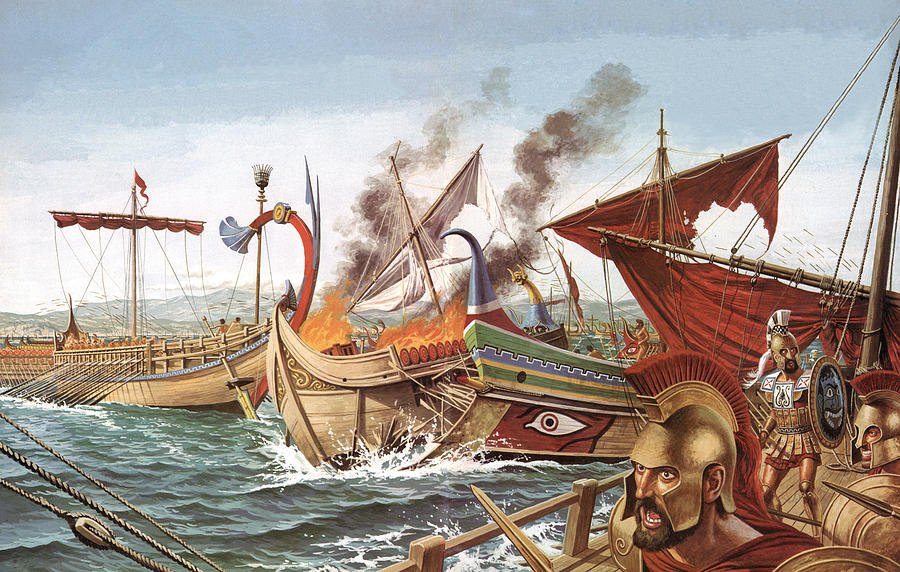
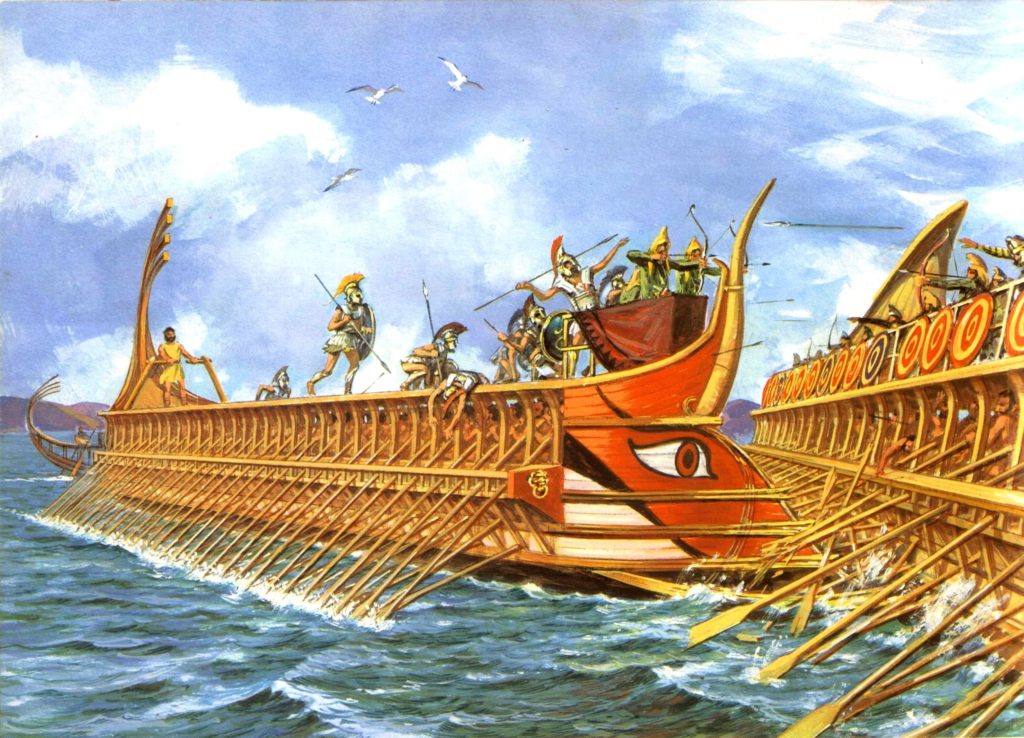
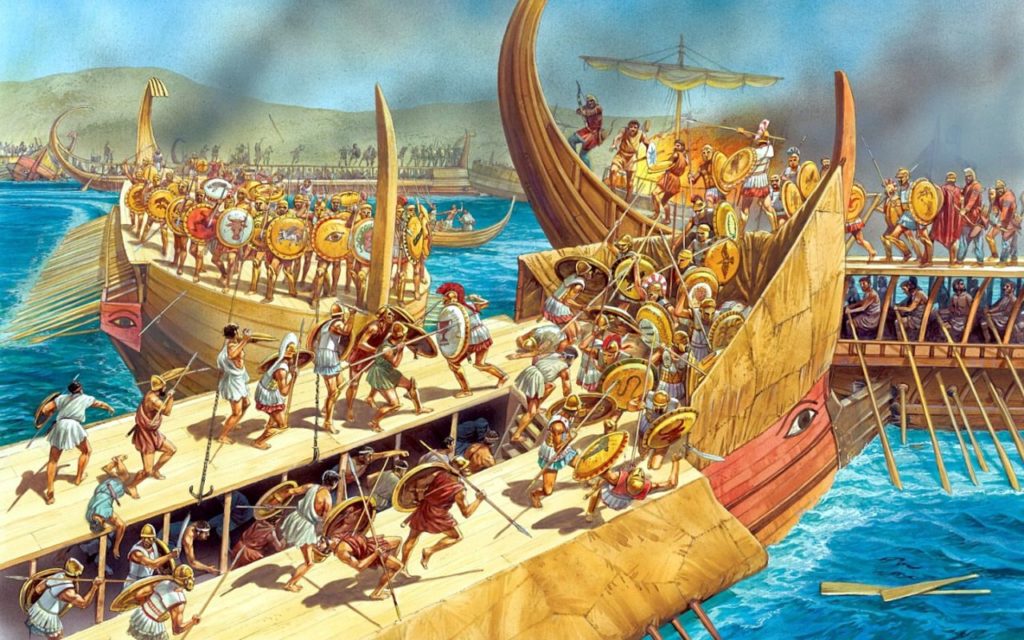
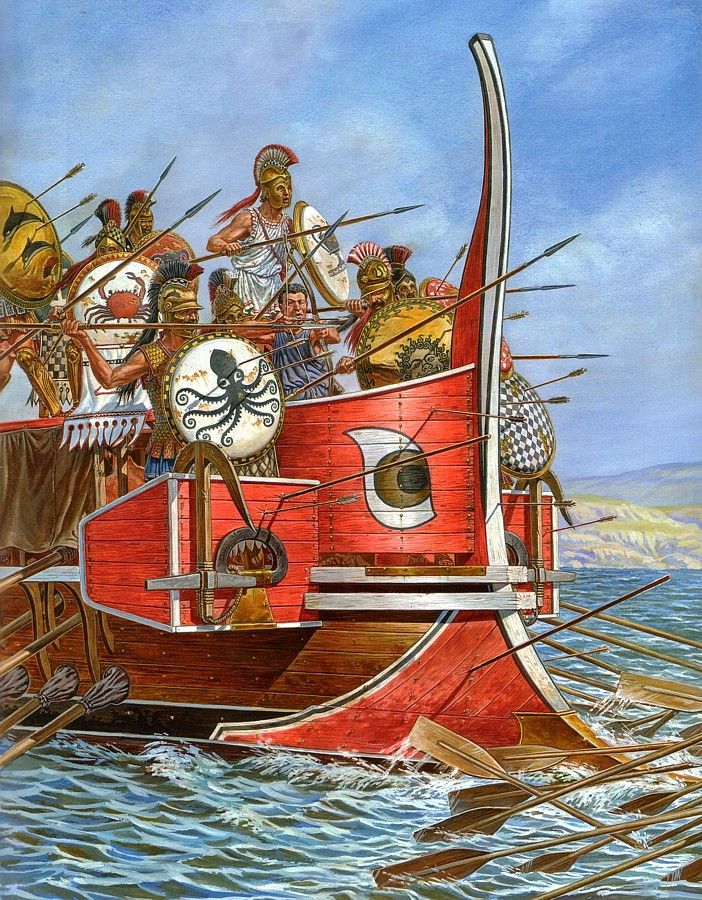
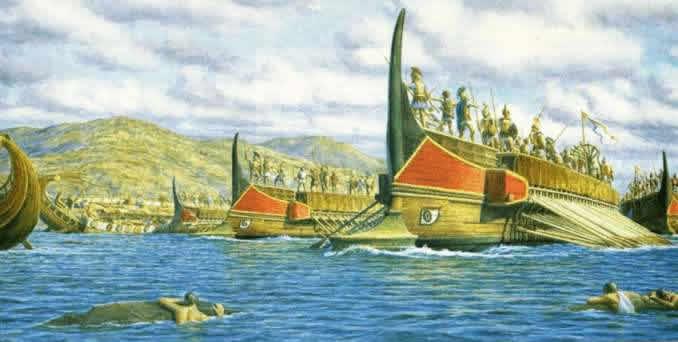
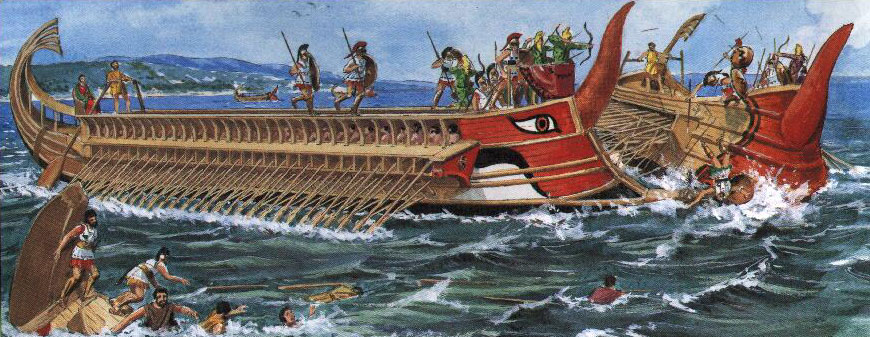
 Latest Facebook Entry -
Latest Facebook Entry -  X(Tweeter) Naval Encyclopedia's deck archive
X(Tweeter) Naval Encyclopedia's deck archive Instagram (@navalencyc)
Instagram (@navalencyc)





 French Navy
French Navy Royal Navy
Royal Navy Russian Navy
Russian Navy Armada Espanola
Armada Espanola Austrian Navy
Austrian Navy K.u.K. Kriegsmarine
K.u.K. Kriegsmarine Dansk Marine
Dansk Marine Nautiko Hellenon
Nautiko Hellenon Koninklije Marine 1870
Koninklije Marine 1870 Marinha do Brasil
Marinha do Brasil Osmanlı Donanması
Osmanlı Donanması Marina Do Peru
Marina Do Peru Marinha do Portugal
Marinha do Portugal Regia Marina 1870
Regia Marina 1870 Nihhon Kaigun 1870
Nihhon Kaigun 1870 Preußische Marine 1870
Preußische Marine 1870 Russkiy Flot 1870
Russkiy Flot 1870 Svenska marinen
Svenska marinen Søværnet
Søværnet Union Navy
Union Navy Confederate Navy
Confederate Navy Armada de Argentina
Armada de Argentina Imperial Chinese Navy
Imperial Chinese Navy Marinha do Portugal
Marinha do Portugal Mexico
Mexico Kaiserliche Marine
Kaiserliche Marine 1898 US Navy
1898 US Navy Sovietskiy Flot
Sovietskiy Flot Royal Canadian Navy
Royal Canadian Navy Royal Australian Navy
Royal Australian Navy RNZN Fleet
RNZN Fleet Chinese Navy 1937
Chinese Navy 1937 Kriegsmarine
Kriegsmarine Chilean Navy
Chilean Navy Danish Navy
Danish Navy Finnish Navy
Finnish Navy Hellenic Navy
Hellenic Navy Polish Navy
Polish Navy Romanian Navy
Romanian Navy Turkish Navy
Turkish Navy Royal Yugoslav Navy
Royal Yugoslav Navy Royal Thai Navy
Royal Thai Navy Minor Navies
Minor Navies Albania
Albania Austria
Austria Belgium
Belgium Columbia
Columbia Costa Rica
Costa Rica Cuba
Cuba Czechoslovakia
Czechoslovakia Dominican Republic
Dominican Republic Haiti
Haiti Hungary
Hungary Honduras
Honduras Estonia
Estonia Iceland
Iceland Eire
Eire Equador
Equador Iran
Iran Iraq
Iraq Latvia
Latvia Liberia
Liberia Lithuania
Lithuania Mandchukuo
Mandchukuo Morocco
Morocco Nicaragua
Nicaragua Persia
Persia San Salvador
San Salvador Sarawak
Sarawak Uruguay
Uruguay Venezuela
Venezuela Zanzibar
Zanzibar Warsaw Pact Navies
Warsaw Pact Navies Bulgaria
Bulgaria Hungary
Hungary

 Bundesmarine
Bundesmarine Dutch Navy
Dutch Navy Hellenic Navy
Hellenic Navy Marina Militare
Marina Militare Yugoslav Navy
Yugoslav Navy Chinese Navy
Chinese Navy Indian Navy
Indian Navy Indonesian Navy
Indonesian Navy JMSDF
JMSDF North Korean Navy
North Korean Navy Pakistani Navy
Pakistani Navy Philippines Navy
Philippines Navy ROKN
ROKN Rep. of Singapore Navy
Rep. of Singapore Navy Taiwanese Navy
Taiwanese Navy IDF Navy
IDF Navy Saudi Navy
Saudi Navy Royal New Zealand Navy
Royal New Zealand Navy Egyptian Navy
Egyptian Navy South African Navy
South African Navy






























 Ukrainian Navy
Ukrainian Navy dbodesign
dbodesign